Music is the universal language
“Glory to God in the highest heaven, and on earth peace to those on whom his favor rests.” - Luke 2:14
General Interest
“It would have been harder to nerd out like I did if I was constantly scrolling TikTok”: Jason Isbell doubts he’d have become a musician if he had the “distractions” kids have today

“Brain rot” – Oxford’s 2024 Word of the Year and now officially added to the OED – feels like a phrase made for the social media era.
Defined as “a perceived loss of intelligence or critical thinking skills… attributed to the overconsumption of unchallenging or inane content,” it’s a sign of the times. Even Jason Isbell admits that if TikTok and Instagram had been around when he was growing up, the constant “distractions” might have stopped him from becoming a musician altogether.
Speaking on Alabama Public Radio’s APR Notebook podcast, the six-time Grammy winner explains how the absence of those platforms gave him the focus to dig deep into his music.
“It might be harder to nerd out in the way that I did and go back and study this music, if I could just constantly be scrolling through TikTok or Instagram or something,” says Isbell. “But at the time when I started making music myself, I got obsessed with it, and I spent hours and hours researching. You know, I would find an artist, and then I would say, Well, who are their influences, and who are their influences? And I would work my way backwards.”
Growing up around the Muscle Shoals area [where the iconic FAME studios resides] in Alabama, Isbell had a unique advantage. The city’s rich musical legacy meant that the local legends weren’t just names in liner notes, but players he could actually watch onstage.
“I could go to a lot of the places and talk to a lot of the people who had worked on these albums,” Isbell recalls. “And you know, the musicians from here in town, Spooner (Oldham) and David (Hood) and Donny Fritz, they would be playing in restaurants and bars, you know, covering a lot of the songs that they’d played on originally.”
“I would order an appetizer and stay for four hours and watch people play these songs. I got very, very lucky,” says the guitarist.
Despite Isbell’s doubts though, apps like TikTok and Instagram have become powerful launchpads for a new generation of musicians. Guitarists like Matteo Mancuso and Sophie Lloyd have built international audiences from viral clips, while countless bedroom players reach millions with inventive riffs and covers. For all its potential for “distractions”, social media platforms continue to serve as important gateways for the next generation of guitar talent.
The post “It would have been harder to nerd out like I did if I was constantly scrolling TikTok”: Jason Isbell doubts he’d have become a musician if he had the “distractions” kids have today appeared first on Guitar.com | All Things Guitar.
“Maximum headroom, tight-tracking low end”: Mesa/Boogie revives the mighty Mark IIC+ HRG amplifier head

Mesa/Boogie has dipped back into its archives to revive two fan favourites: the Mark IIC+ HRG tube amp head and the 1×12 Vintage Thiele Cabinet. Long associated with Dream Theater’s John Petrucci and countless high-gain players, the HRG now gets its first reissue on the IIC+ platform, alongside the cabinet that became its perfect match.
The HRG (Hundred-Watt/Reverb/Graphic EQ) was born in the firm’s Lagunitas Shop days, where founder Randall Smith crafted custom rigs from an expanded menu, offering the ‘Super Sixty’ Boogie as the base model platform to build upon. The format quickly earned a reputation for immense clean headroom, ferocious lead tones and tight-tracking low end – qualities that also made it a go-to for ‘crunch’ rhythm work in heavy rock and metal.
Now back in production, the Mark IIC+ HRG brings 100 watts of power with onboard Reverb, Graphic EQ, and all the snarling bite players expect from the platform. Mesa/Boogie says the reissue can “play clean in Rhythm Mode at high volumes before clipping” while delivering “super-tight low end” and searing gain in Lead Mode.
Powered by four 6L6 tubes and a preamp section stacked with five 12AX7s, the head also features independent master controls, footswitchable Rhythm and Lead channels, and a half-power switch to tame the beast down to 60 watts.
 Credit: Mesa/Boogie
Credit: Mesa/Boogie
Alongside the amp comes the return of the Vintage Thiele 1×12 Cabinet. Originally designed in the early ’80s for the Electro-Voice EVM12L speaker, the front-ported, compact cab became a secret weapon for players needing massive low-end punch from a portable rig.
This new edition comes loaded with Mesa’s proprietary Celestion C90 speaker, and is available in Black Vinyl or Wicker grille finishes.
 Credit: Mesa/Boogie
Credit: Mesa/Boogie
Doug West, Director of Tone Lab at Gibson Amplifiers and MESA/Boogie, says: “This sealed and ported design became synonymous with huge tone in the ’80s, when players and artists alike discovered it was a secret weapon for delivering massive low end far beyond its physical footprint, along with a tight, punchy overall sound.”
The Mesa/Boogie Mark IIC+ HRG is priced at $3,599, while the Vintage Thiele 1×12 Cabinet lands at $799.
Learn more at Mesa/Boogie.
The post “Maximum headroom, tight-tracking low end”: Mesa/Boogie revives the mighty Mark IIC+ HRG amplifier head appeared first on Guitar.com | All Things Guitar.
Legendary luthier Ken Parker – creator of the Parker Fly – launches crowdfund to pay for cancer treatment

Ken Parker, legendary luthier, founder of Parker Guitars, and creator of the iconic Parker Fly, has launched a crowdfund to raise money for his cancer treatment.
In a heartfelt note on his GoFundMe page, Parker shares that he was diagnosed with a rare form of cancer in early 2023, and that the illness has steadily eroded his ability to work.
“It hasn’t been easy living with this nasty disease, having chemo treatments that zapped my energy and slowly took away my ability to earn a living,” he writes. “Now, I’m on a breathing machine 24/7 and I’ve started to lose the use of my left arm. I humbly ask for your support to reduce the medical and personal debt that I’ve incurred and to help with my family’s expenses.”
- READ MORE: The history of the Parker Fly
Reflecting on his career, Parker adds, “Throughout my life, I’ve done something that I love and am proud of – making guitars that advance the art, science and craft of building far beyond traditional methods. Most importantly, it has been a true joy and especially gratifying experience to see my guitars in the hands of all of you gifted and aspiring players, and I thank you for that opportunity.”
In a video released earlier this week, Parker – who in recent years focused on building custom archtops – also announces his retirement from day-to-day guitar building to focus on his health. Aided by a breathing machine, a visibly frail Parker explains that much of the past year has been dedicated to passing his knowledge and techniques on to his colleague Sam Krimmel.
“Sam has this gift which feels remarkably similar to the gift that I feel that I have that’s allowed me to do my work,” he says. “I’ve never had a deeper and more interesting work relationship on a daily basis than I have with Sam, and we work together very, very well.”
Krimmel, who has an engineering background, has been apprenticing under Parker full-time for the past year, “learning the intricate details of assembly while simultaneously developing new production techniques to improve part quality and consistency.”
He’s now tasked with carrying on the innovations that defined Parker’s five-decade career.
“Ken’s mission has been to pass on physical design ideas to Sam to empower a brilliant new set of hands,” the video description notes. “Sam’s mission is to continue to share the stories of innovation, creation, and industry altering ideas that define Ken’s work.”
“To honor Ken’s unfathomable contributions to the guitar industry, let’s keep the band together.”
The fundraiser is now live, with USD $95,298 raised out of its $450K target at the time of writing.
Contribute to Parker’s campaign at GoFundMe.
The post Legendary luthier Ken Parker – creator of the Parker Fly – launches crowdfund to pay for cancer treatment appeared first on Guitar.com | All Things Guitar.
Positive Grid BIAS X review – “it’s like having a virtual studio engineer doing the hard work”

$149, positivegrid.com
For the last few years Positive Grid has been busy redefining what we expect in terms of sound, usability and flexibility from our practice amps in the shape of the wildly popular Spark family of products.
However, before PG became the world’s foremost purveyor of tiny amps, there was BIAS – a powerful, great-sounding and hugely popular amp and effects plugin. BIAS has percolated away in the background for the last few years, getting regular updates and building a reputation as one of the best sounding and most user-friendly guitar plugins around. Now though, things are really getting interesting with the launch of BIAS X – a brand new platform that’s brings a lot more ahem, intelligence, to the party.
 Image: Press
Image: Press
Positive Grid BIAS X – what is it?
BIAS X is an in-the-box (that’s on your computer, by the way) amp and effects suite – with a twist. Billing itself as the first AI-powered ‘tone creation platform’, BIAS X provides you with 30+ amps, 60+ effects, a whole bunch of cabs and the ability to combine those in any manner you desire. The twist is that you don’t have to do the tweaking – thanks to the AI Assistant built into BIAS X’s user interface, you can simply tell the AI what sort of sound you’re looking for (or even upload a snippet of a tone you want to emulate) and quick as a flash it’ll create a plugin catered to your requirements.
The idealised version of all this effectively casts you as a megalomaniacal 80s rock star at the height of their money-no-object studio excess. The concerns of regular guitarists who have to set up their own gear or tweak their setups to get the sound they’re after are, frankly beneath you – you have underlings for that.
In this scenario, the BIAS X AI Assistant effectively playing the role of an eager to please virtual studio engineer sat beside you doing all the hard work and catering to your every whim no matter how unreasonable. Except the AI doesn’t require constant cups of tea to keep functioning, and is unlikely to demand a writing credit on the album because they came up with a maraca part that’s buried so deep in the mix you’d need Jacques Cousteau to find it.
Taken at face value, that all sounds rather appealing doesn’t it? Especially if, like me, you’re someone for whom the world of in-the-box recording is approached with a mixture of reticence and outright disdain precisely because you find the thought of spending half an hour constructing a signal chain using a mouse and keyboard a special kind of torture.
Getting a LLM to do the lion’s share of the work for you seems like one of those ‘actually worthwhile applications of AI’ that I’ve been hearing about but seeing precious little evidence for. Let’s find out if it lives up to that expectation…
 BIAS X GUI. Image: Press
BIAS X GUI. Image: Press
Positive Grid BIAS X – who is it for?
Now, before we get into the testing part of all this, it’s probably worth having a quick sidebar here for existing BIAS users. If you’re expecting BIAS X to be BIAS FX 2 with a shiny AI helper in there, you’re going to be disappointed – at least at launch.
Because some of the important stuff that you might be expecting just isn’t there in BIAS X. For starters you get barely a third of the number of amps and effects as you do in BIAS FX, and you also won’t find the nerdy component-level tweakery that made it such a popular platform for guitar players.
Instead, this feels more like a bridge between the casual nature of the hugely popular Spark platform and its companion app, and the more involved world of ITB guitar playing – it’s probably not a coincidence that Spark also has 33 onboard amps, for example.
That doesn’t mean that BIAS is underpowered or lacking in features and usability, however – it’s every bit a modern high-end amp and effects plugin, just one that’s a little more streamlined with its sounds out of the gate.
That means you can still create the most long and unwieldy chain of effects your processor can handle – complete with dual amp and cabs if you so desire. I finally got bored having created a chain of over 40 amps and effects, with my M2 MacBook Pro’s chip still only showing 43% use (this handy DSP readout in the top right corner will come in handy if you’re using a less powerful machine however). You can also upload your own IRs in place of the inbuilt cab options, and of course adjust the mic placement accordingly.
 Image: Press
Image: Press
Positive Grid BIAS X – in use
Now, as mentioned up top, I am one of those people for whom the whole amp and effects software thing has been firmly placed in the ‘not for me’ category. Despite being a very techy person generally, when it comes to guitar I prefer things to be as simple and analogue as possible. That said, I have in recent years had my head turned by the simplicity and usability of Positive Grid’s Spark products in a practice scenario… maybe BIAS X can turn my head similarly?
I might be somewhat ITB-sceptic, but I’ve used enough amp and effects plugins in my time to know that it’s useful to have a basic play around to get a clean tone you’re happy with before taking the leap into the agentic unknown. If nothing else, this is about setting your input levels and other boring stuff to give the fancy stuff a better chance to work – and so I quickly jack into BIAS X’s interpretation of a Deluxe Reverb and make sure my levels are where they need to be and everything sounds good.
This is one thing to very much be aware of in all this before we get the AI involved – the software can only create something it thinks will work, but a big part of actually sounding good is what you’re plugging into it. While I did experiment with trying to cajole the AI into creating presets specifically for guitar types, I didn’t have a huge amount of joy here – expect to have to refine your EQ to your specific guitar and its pickups.
There are a bunch of factory presets in BIAS X that offer the full gamut of tones from crystal cleans to the heaviest chugs – but that’s not why we’re here is it? Let’s click that little diamond-shaped button on the bottom left of the interface and get chatting.
There are two ways to interact with the assistant – either you can put in a text prompt and let the AI make its own mind up, or you can drag and drop an audio file and it’ll do its best to match the tone onboard.
We’ll start with the text-to-tone option, and out of the gate it’s worth noting that, if you’ve had any previous experience trying to get something useful out of an LLM, you’ll know that it helps to be quite specific in the way you prompt it.
While the Assistant’s Quick Tips encourage you to ‘describe a mood, idea or favourite artist’ to get a sound you want, I quickly realised that it helps to add as much detail as possible. “Give me an Oasis tone” is going to provide a much more complex set of variables for the AI to work with than if you ask it to, “Give me a guitar tone similar to Oasis’s Supersonic – the saturated distorted tone of a cranked amp with lots of bottom-end and slight slapback delay”.
In truth the AI does a pretty decent job even with more basic prompts, but you’ll have to accept a certain degree of refinement is necessary here. Thankfully, the Assistant is more than happy to help make minor tweaks and broadly does a nice job of it – ask it to ease back the gain or take some of the top-end out of a sound and it’ll quickly present you with an updated preset to try out.
One slightly weird eccentricity I noticed in this regard was its predilection for chucking an EQ pedal into the chain willy nilly. If you ask it to roll off some of the top end or boost the mids, it will usually respond by chucking a six-band graphic EQ into the chain, when all that really needed to happen was a roll off of the tone stack on the amp. Quite often this also sounds bad, and is easily remedied by being more specific with the prompt, but it’s a good reminder that as with any AI agent, you are not in fact talking to a living breathing virtual tea boy, and expecting it to show initiative or common sense is not always a guarantee.
Where it was more impressive was when things get weirder – asking it to craft Jack White’s glitchy octave-overloaded Blue Orchid guitar tone yielded a very solid result out of the gate and with a couple of gentle prompts I was working with a much more usable and convincing recreation than I’ve ever managed with a bunch of fuzz and pitch-shifting pedals myself.
It should also be noted that these amps and effects sound exceptionally good across the board. Positive Grid boasts about the component-level circuit modeling that goes into their sounds, and while you may not be able to tweak them to taste here, the results are still remarkably faithful to the originals. Too often ITB amp and effects plugins are judged purely on their heavy tones,but I was pleasantly surprised with the crunchy lower-gain offerings here – they sounded rich and authentic. With that in mind, it was quite frustrating that the Assistant consistently seemed to default to higher gain options than I had specified, occasionally choosing woefully inappropriate amps or pedals in the service of more distortion that I had never really asked for – a system is only as good as the data it’s trained on I suppose, and the bulk of BIAS users are going to be leaning more towards heavy tones.
 BIAS X AI Assistant. Image: Press
BIAS X AI Assistant. Image: Press
Positive Grid BIAS X – should you buy it?
There are of course other issues to consider when you insert the word ‘AI’ into any product – both environmental and ethical. It’s very hard to quantify how much BIAS X is contributing to Generative AI’s boiling of the planet – though I’d wager it’s a drop in the literal oceans compared to all those chronically unfunny ‘me as an action figure’ posts that were everywhere a few months back.
Less clear-cut is the issue of exactly how BIAS X has become quite so clever at building guitar tones. Positive Grid says that in addition to “component-level circuit modeling” of the amps and effects the AI Assistant was trained using over 1 million “guitar tones spanning eras, genres, and techniques.” Now, the question you may well be asking is where exactly did that massive data set come from? I posed this question to PG, who told me that while they will use anonymised user data from BIAS X to continue to train the Assistant to improve it over time, they were unable to provide any concrete information as to where the original dataset was compiled from.
It’s an unsatisfactory answer, to be honest – especially when there is huge controversy across the world right now over what is acceptable data to use to train a generative AI product on, and what isn’t. But ultimately, the importance of these issues is very much in the eye of the beholder. It will be absolutely critical to some, and utterly inconsequential to others – with many sat in the middle mainly concerned with whether it works or not.
And work it absolutely does. Granted, if you’re already a whiz at crafting your own presets, tweaking things at the granular level and knowing exactly what you need to get to the sound in your head, the utility of the AI Assistant is somewhat limited, handy as it undoubtedly is.
But I don’t really think that’s who BIAS X is for – in many ways it feels like a way to graduate people from one of the Spark amps into a more professional and advanced world, without the massive difficulty spike that usually comes with it.
With a really simple and easy to use interface, great tones across the board and a good spread of all the classic amps and effects you might need, BIAS X is the perfect amp and effects sim for people who don’t want to make it their entire personality.
In my time with BIAS X, I genuinely found myself having fun with a guitar plugin in ways that I never had before, and that’s all down to the power and usefulness of the Assistant. It’s a shame there’s not a demo version or a free trial really – while BIAS X looks good on paper, it’s only really in practice that you appreciate its game-changing potential. The more people they can get trying it, the more impactful it’s likely to be.
Positive Grid BIAS X – alternatives
The most famous name in the guitar plugin scene is IK Multimedia’s AmpliTube 5 – it was one of the very first bespoke amp and effects platforms and has evolved and grown over the last decade or so to become a hugely varied and good sounding product. It’s starting to show its age in terms of usability now however. If you want quality and huge choice in one package, it’s hard to look past Line 6’s Helix Native – if you can think of it in terms of amps, effects and such, it’s in there. Another simple to use and well-stocked option that’s perhaps a little on the elderly side now is Native Instruments Guitar Rig 7.
The post Positive Grid BIAS X review – “it’s like having a virtual studio engineer doing the hard work” appeared first on Guitar.com | All Things Guitar.
Mastering the Art of Session Guitar: Tips from Nashville's Finest
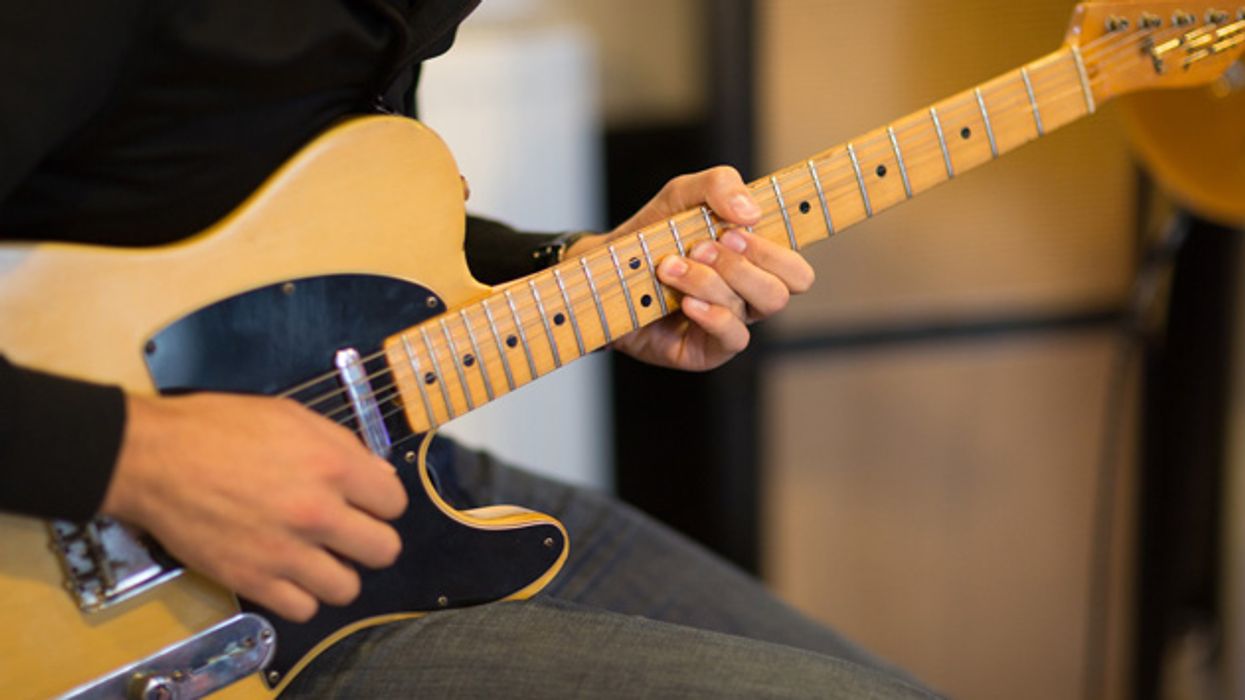
I feel a little embarrassed when people ask me about my guitar influences. I can't claim expertise of Hendrix, I haven't spent hours woodshedding Eric Johnson, and I couldn't tell you the first thing about how to play like David Gilmour. My influences are more behind the scenes, lurking in the shadows of the music industry. They don't have big names, but they are monster players. I'm talking about the number one, most honest influence on my guitar playing: Nashville session guitarists.
In case you don't know, Nashville session guitarists are the cream of the crop—they have to be. Their job is to listen to a song once, write a chart for it during that single listen, step out onto the tracking room floor and simultaneously create, react, and execute a guitar part at a radio-perfect level in one take. I've figured out some tricks by studying the work of musical sharpshooters like J.T. Corenflos, Kenny Greenberg, and Tom Bukovac, and now I get to apply it in my own career when I'm called in for a session. Now, let's steal some tricks.
“Kiss You in the Morning" Box
An important thing to remember throughout this lesson is that the goal is to sound perfect. A dead note on your guitar solo should not be the reason that one of your fellow session players is late to pick up his daughter, so this is no time for finger tapping or seven-fret stretches. I call this the "Kiss You in the Morning" box because it's similar to the signature lick in Michael Ray's song of the same name.
You want the song to sound good, which means you need to sound comfortable. That's why this pattern (Ex. 1) is a great home base for your chord-based riffing. This is a segment of a diagonal major pentatonic scale that only uses your first and third fretting-hand fingers. You don't have to stretch or remember complicated patterns, and it's almost impossible to sound bad here. Place your first finger on the chord's root, which falls on either the low 6th or 5th string, and slide your third finger up two frets to access the rest of the pentatonic notes. It's a closed shape, so you can move it all over the fretboard to whatever key or chord you need, which comes in handy when you're scanning down a Nashville number-style chart in real time and having to come up with a hook or rhythmic motif.
The “All About Tonight" Box
This one is a little tougher, but more rewarding. I could do an entire session just using this box and rearranging the notes in different ways to make my melodies and textures fit the mood of the song. You can hear hints of this pattern in Blake Shelton's "All About Tonight." This is a natural extension to the previous example, but in Ex. 2 we start to introduce double-stops (playing two notes at a time). Low notes on the lower strings sound thick on their own, but as you move up the neck it's a good idea to start using double-stops if you want to keep the guitar sounding thick. In this box, your first finger is always in charge of the same fret, and your third finger oversees hammer-ons two frets higher. To play the double-stops I'm talking about, barre the 5th and 4th strings with your first finger and pick them. Then hammer on the 5th string with your third finger. Boom. You can do the same trick with different string sets.
Open for Business
You've got some lead chops built up, but somebody will be singing for 90 percent of the song, so what do you do? In keeping with our rule that we want our playing to sound comfortable, the answer is open chords. Full barre chords give you a lot of strings to keep track of, and if your dynamics, sustain, and muting aren't spot on, then the producer is going to have to hire someone to redo your parts after you leave, and that doesn't bode well for your session career.
Throw on a capo because only five keys are generally acceptable for playing guitar in a session: G, D, E, C, and A. Is the song in Db? Put a capo on the 1st fret and play in C. How about F#? Place a capo on the 2nd fret and play in E. Even if a song is in A, 95 percent of the time the acoustic guitar player will opt to play with a capo on the 2nd fret so he or she can move around comfortably in the key of G. Ex. 3 shows some of the special open chords that session players use all the time.
Palm-Muting Verses
Wide-open chords aren't everything, though. Songs need to have structure and flow, and the band members need to be on the same page about where the song is going. If you watch a session with guitarists Derek Wells and Jerry McPherson both playing guitar, they aren't clashing. They both know how energetic the song needs to be at any given moment. Chances are you'll nail it if you play the verses a little lower in energy and the choruses a little higher in energy. You can palm-mute the lowest two strings of an open chord, or you can palm-mute a power chord, or you can palm-mute thirds that fit inside of the chord. Check out Ex. 4 for an example. Any of those routes will work to get you from the intro to the chorus. And when it comes time to do a "fill" at the end of the measure or progression, all you really need to do is unmute what you're already doing! Fish in a barrel.
My Kinda Drones
"Box" playing is great, but I'm sure you want to have more than just boxes in your toolkit. One of the best tricks for coming up with melodies that don't sound boxy is by using what I call "My Kinda Party" drone lines. The signature lick in Jason Aldean's song, "My Kinda Party," is a wonderful example of this. Come up with a melody and play the whole thing on the 2nd string. Don't get too complicated, and don't make it too fast. Make it a nursery rhyme, a simple, hummable jingle that a drunk Bonnaroo crowd could sing back to you.
To allow the 1st string to ring out as you move along the neck, you need to fret the notes on the 2nd string using the very end of your fingertips. Now pick through both the top two strings while sliding from note to note (Ex. 5). This adds thickness and texture to the melody and helps make it sound like music, so someone like super-producer Justin Niebank doesn't have to spend time adding effects to your guitar to fill out the mix. As with the open chords, make sure you have the capo in the right spot so the open 1st string fits the song's key.
Get Low
The opposite of that approach is using a technique found in Luke Bryan's tune, "We Rode in Trucks." With this trick, you place the root of the chord on one of the lower three strings and build your melody on the string above it (Ex. 6). My favorite application of this is when you hammer-on to a 3, which puts your hand right in the "All About Tonight" box we talked about earlier if you need to launch into a solo. This trick can only be done if one or more of the low open strings works with the song's key, so you'll have to do some quick mental math and capo accordingly.
Swell into It
This technique is one of the physically easiest to perform, but requires some mental energy to get right. Sometimes the song needs an ambient volume swell to hold things together over chord changes, and this requires choosing your notes carefully. Let's say the progression is Em–C–G–D, with two chords per measure. Look for the notes that both chords share in each measure. Em and C both share E and G notes; G and D both share D notes.
That's the safe route, but you can also swell into notes or pairs of notes that challenge the chord a little bit and make an extension out of it. Swelling into a D over the Em and C turns them into Em7 and Cadd9, respectively, both very cool sounds. And G to D is a pretty strong chord change in this key, so you'll probably want to stick the landing and end up on chord tones here. To change things up from just a D note you can swell in a pre-bent G note and let it down to an F# when the D chord comes in. Or do the same thing, but pre-bend a B note and let it fall to an A (Ex. 7). You can nail this approach if you know your chord tones. Note: You'll need a good amount of delay and reverb to make the most of your swells. Most players do this with a volume pedal, but with the right guitar—a Strat, for example—you can also accomplish this manually.
High Extensions
Now that we're in the mindset of thinking about what our notes do to the chords we're playing over, adding higher extensions can introduce complexity and texture to a song. I have fond memories of sitting with a friend in high school, both of us holding acoustic guitars, and playing different triads and double-stops over each other's open chord strums—just to hear how one person's triad could affect the other person's chord.
The idea is that you'd pick notes that might not be within the basic triad and use these additions to alter the song's principle chords. If a bass player plays a C, and the acoustic guitar plays an open C chord, and the other electric guitarist plays a C power chord, but you play a B and D double-stop high on the fretboard you just made the entire band sound like a Cmaj9 chord, which is really pretty sounding. If you pick G and Bb, then you made the band sound like a C7 chord, which is bluesy and sarcastic sounding. Session players know what note extensions to add to chords, what these extensions will sound like, and when it's appropriate to use them. Ex. 8 illustrates how to use this trick over a basic progression.
Simple Slidin'
On most sessions, slide is used for texture and not for Derek Trucks- or Sonny Landreth-inspired shredding, so it's mostly limited to chord tones and a couple of simple lines. It is a very cool color, though, and it's well worth learning how to navigate a melody with a slide on your pinky. Slide sounds more like a human vocal than fretted notes, so this technique can really lend itself to making memorable, catchy, singable hooks. This is part of the reason guitarist Rob McNelley is on so many records—he's able to really make slide sing. Just be very careful about not letting strings ring unless you want them to. To come up with a simple, catchy, single-note slide line that soars over the arrangement, tap into the same melody-creating brain space you used for the "My Kinda Party" example, as well as the chord knowledge required for swells and extensions. Chord tones are always safe, extensions can be really cool, and make sure you stick the landing (Ex. 9).
Dot … Dot … Dot
You made it all the way to Ex. 10, so give your brain a break and let a pedal do all the work. Delay is a powerful effect, and when you sync that delay to the song tempo, the pedal can play notes for you. If you see guitarist Justin Ostrander doing something simple, chances are there's a timed delay happening to carry the simplicity. A dotted-eighth is equal to three 16th-notes, and a dotted-eighth delay means once you play a note, that note will come around again three 16th-notes later. And if the repeats are turned up, it'll keep repeating every three 16th-notes to create a cool syncopated feel (Ex. 10).
If you play something completely straight against the syncopated pattern the delay will be creating, the delay fills in the notes between what you're playing and makes an otherwise boring figure sound incredibly interesting. To make this trick work, you'll need a delay with programmable or tap tempo. For best results, tap the tempo for quarter-notes, play eighth-notes, and have the delay set for dotted-eighth-notes.
These guitarists stay mostly out of the spotlight, but with the growing world of media they are starting to get a little more exposure with great programs like Premier Guitar's Rig Rundown with Kenny Greenberg (shown below) or Zac Childs' Truetone Lounge episode with Derek Wells.
Videos like these let you inside the world of the pro session player, and are great resources for learning more from the best in the business. Next time you hear some tasty guitar on a radio hit, you'll know it's tasty for a reason and you're one step closer to being the guitarist who gets to play it.
Lamb of God Return with “Sepsis”
Lamb of God return with “Sepsis”, a visceral, menacing new single out now via Epic Records, marking the GRAMMY® Award-nominated band’s first new original music since 2022’s critically revered album, Omens. Produced by longtime collaborator Josh Wilbur, the three-and-a-half minute track arrives alongside a grainy, lo-fi performance video that offers a moody, unfiltered look at Richmond’s underbelly. Directed by Gianfranco Svagelj, the video captures the song’s slow-burning tension.
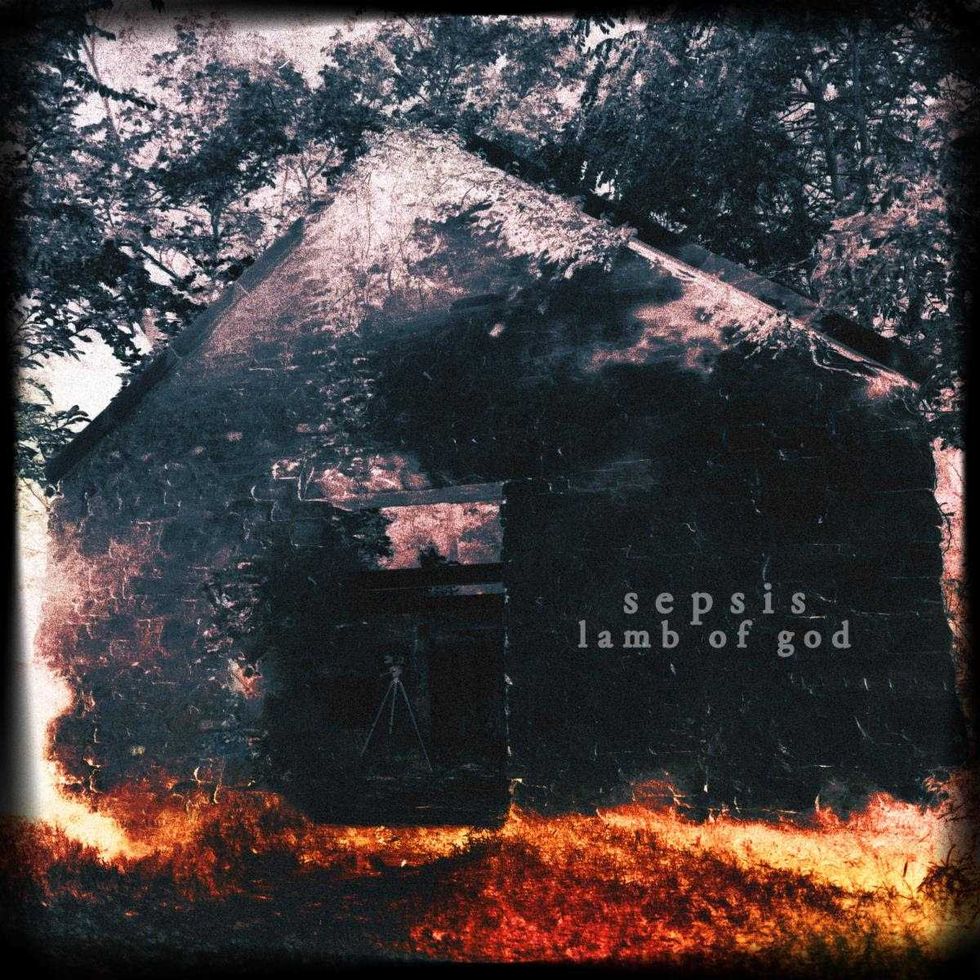
“’Sepsis’ is a celebration of the very underground local bands here in Richmond that we really admired when we were just forming Burn the Priest,” Mark Morton shares. “Bands like Breadwinner, Sliang Laos, and Ladyfinger—though they never got widespread attention outside of Richmond, those were the bands we listened to all the time. The song references that stuff in a way that’s a direct line to where we were coming from when we were in the basement writing our earliest material together.”
“Sepsis” arrives during a milestone year for Lamb of God. In 2025, the band celebrated the 25th anniversary of their discography, performed at the historic “Back to the Beginning” concert and subsequently released their thunderous take on Black Sabbath’s “Children of the Grave,” along with appearances at several festivals including Inkcarceration and Louder Than Life, and a headlining show at Richmond’s new 7500-seat outdoor venue, Allianz Amphitheater, during its opening season.
As the year closes, Lamb of God have several performances ahead of them, including outings at Aftershock, AMMA Championship Fest, and the band’s Headbangers Boat cruise (Oct. 31 to Nov. 4) – a four-day floating festival departing from Miami with a stop in Cozumel, Mexico. The line-up features performances from Clutch, Kublai Khan TX, Power Trip, Obituary, Devil Driver, Fear Factory, The Black Dahlia Murder, The Exploited, Crowbar, Nekrogoblikon, Eighteen Visions, Gideon, Walls of Jericho, Category 7, Brat, comics Josh Potter and Saul Trujillo, with appearances from Jose Mangin and Riki Rachtman. Tickets are available at Headbangersboat.com.
Lamb of God tour dates:
October 3 Sacramento, CA Aftershock Festival
October 18 Canton, OH Tom Benson Hall of Fame Stadium
October 31 – November 4 Miami, FL Headbangers Boat
November 6 Monterrey, MX Showcenter Complex
July 27 – 31 Râşnov, RO Rockstadt Extreme Fest
August 1 Wacken, DE Wacken Open Air 2026
August 7 Walton-on-Trent, UK Bloodstock Open Air 2026
August 12 – 16 Dinkelsbühl, DE Summer Breeze
August 13 – 15 Sulingen, DE Reload Festival
August 14 – 16 Eindhoven, NL Dynamo Metalfest
Tickets for all shows are available now via Lamb of God’s website.
How a Four-Pickup Vintage Teisco Electric Continues to Inspire
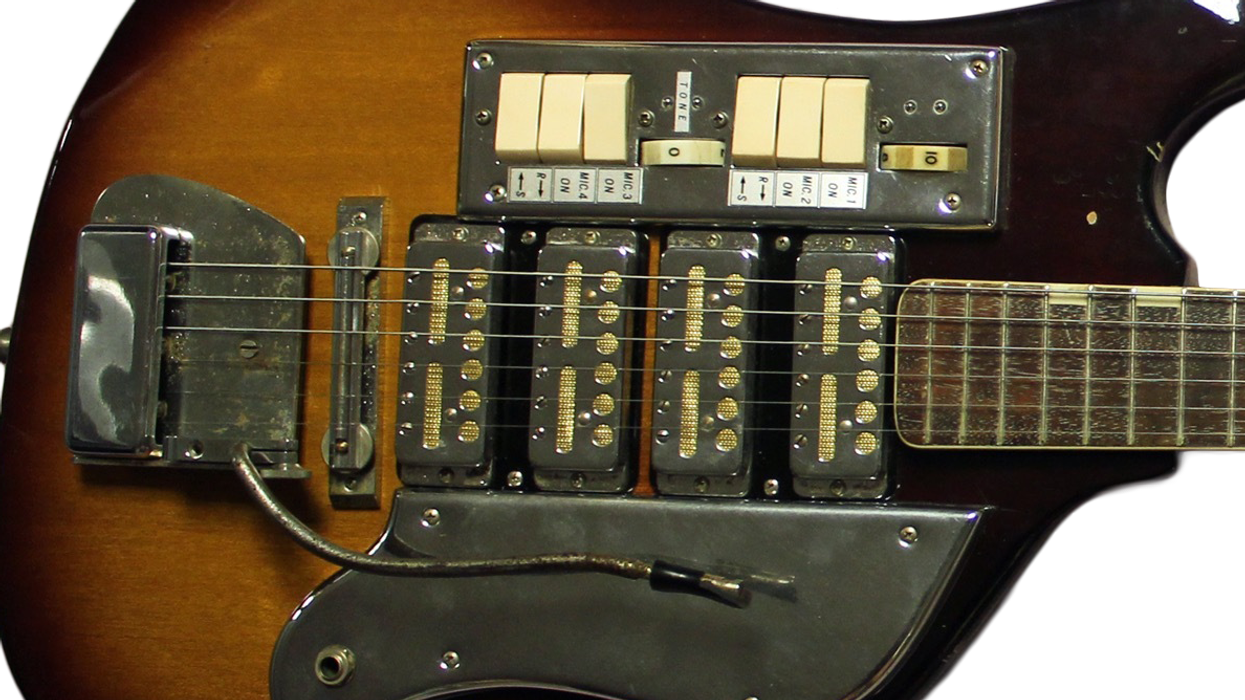
Lately, I’ve been thinking about coaches and teachers—you know, the people in your life that have brought out the best in you. My daughter is now off to college, and my son is entering 10th grade, so I’ve been reflecting on our common experiences. My boy is playing sports and currently has a pretty good coach. The guy is supportive and involved, but still has a little "old-school" in him. When I was a kid, my coach was a “bucket” coach, meaning he brought a five-gallon bucket onto the field and flipped it over so he could sit and criticize everything we did wrong. He’d throw his hat and cuss and generally rule by intimidation! Times have certainly changed, brothers and sisters.
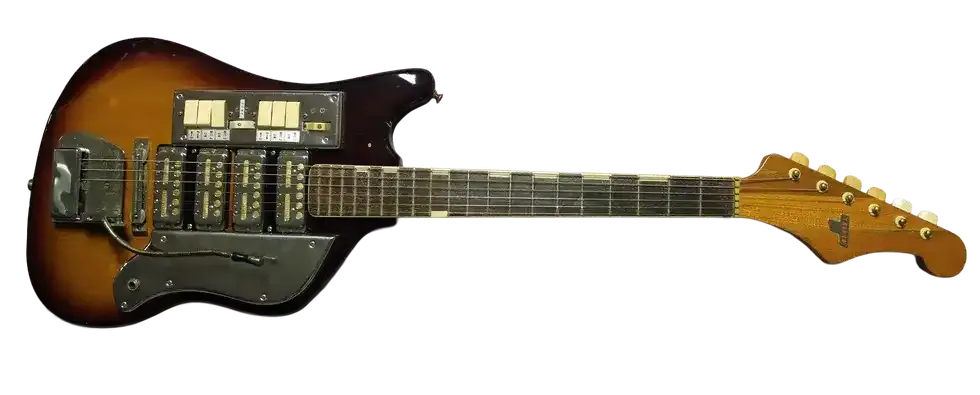
In my old age, I’ve come to learn that the best teachers and coaches were the ones who were excellent motivators: the people who could bring out the best in your performance and learning. Often, motivation comes from knowing that you’re seen and valued, even if you aren’t the sharpest knife in the drawer or the best athlete on the team. These types of people can be hard to find, but we all certainly remember them.
For me, it was Mr. Bryant in the 12th grade. He was a coach, a musician, and a phenomenal educator. I had just lost my dad before my senior year, and he totally tried to lift me up to keep playing sports and stick with guitar. He was a drummer but still had a fine guitar collection, and he would let me choose any one to play. He’d always ask which guitar “spoke” to me. Was it looks, feel, playability, sound, or something else? It’s like when Harry Potter’s wand found him, I suppose. So I ask you, faithful reader, which guitars speak to you? Which guitar gets you motivated to play, and which one inspires you as soon as you play it? Are you still on the hunt, or has your magic wand found you?
My most inspirational guitar is the early ’60s Teisco SS4L. Hailing from the beginnings of Teisco, the SS guitars were among the first to feature the now-famous gold-foil pickups. Of course, the 4L had a quartet of them! This is a guitar where everything is exaggerated to an absurd degree. The electronics feature four switches (pickup on/off) and multiple tone knobs and presets between the rhythm and lead circuits. The body is all out of whack, almost like a goofy-looking potato, and the headstock is elongated to excess. And then the chrome … like an old muscle car! The tremolo on this particular one is a very sophisticated floating unit that’s held together by string tension. Not the easiest to change the strings. These guitars came with one to four pickups and were primarily made from 1962–64. There is every flavor of sound in this guitar, something for every palette. Thin surf, raging blues, spaghetti western … you name it.
“There is every flavor of sound in this guitar, something for every palette.”
These SS4L guitars always inspire me to play because they offer all kinds of adjustments to the tone and tend to bring out the best in my playing. Normally, I’m a set-it-and-forget-it player. But with these guitars, it’s a chance to get creative, and the pickups add to the stew. The body feels kinda clunky and doesn’t balance very well, but the necks all have a nice, deep, full feel, often with a pronounced V-shape, which I totally dig.
I think I currently own four of these guitars, but the one pictured with this column is hanging right by my work bench to offer me a little motivation. I have plenty of nice guitars. Some play better, some feel better, and some sound better. But for whatever reason, I am drawn to this model, and that infatuation has lasted through the years. Oh, and you know what else? The “bucket” coach that I had still comes to watch football practice! He’s not always on a bucket these days, and he’s not yelling at anyone, but he’s still motivated.
Stompboxtober 2025: StewMac

Stompboxtober is back for 2025! Come back all month long for your chance to WIN daily pedal giveaways. Today's featured giveaway is the StewMac Ghost Drive!
Stompboxtober 2025 - Win Pedals All Month Long!
Ghost Drive Transparent Overdrive Pedal
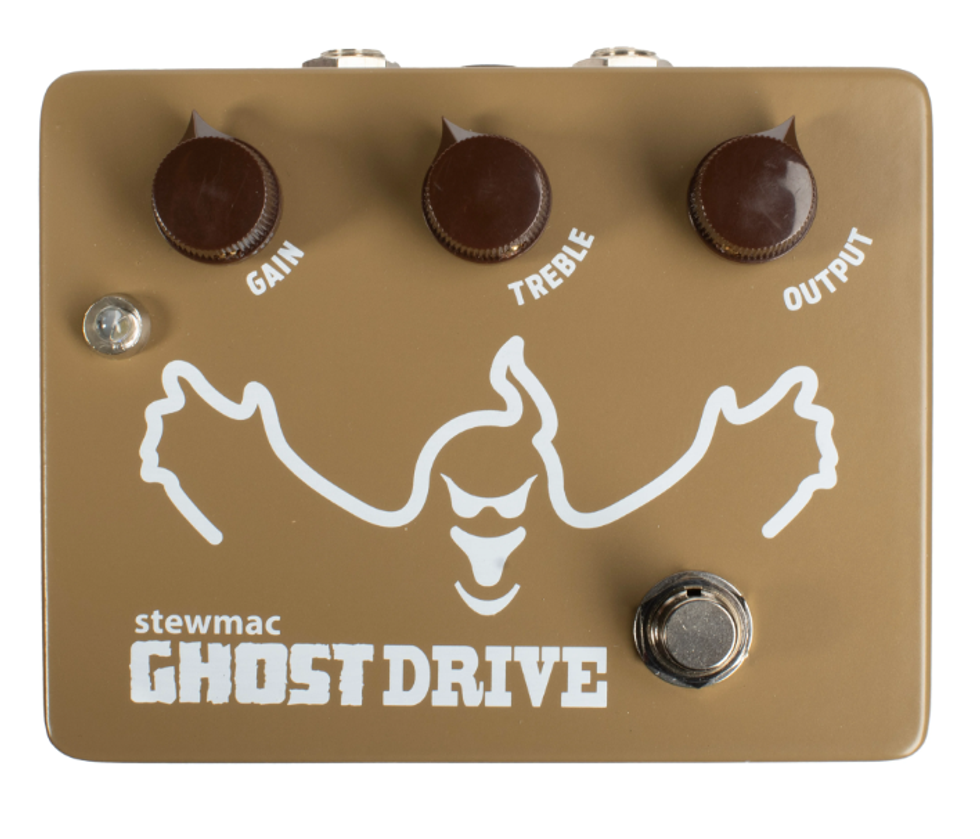
Four years ago, we put our heads down and dove headfirst into the most hyped pedal of all time. We wanted to see what really made the mythical Klon Centaur Transparent Overdrive so special—what was inside this thing that turned it into legend. We pulled it apart, piece by piece, to deconstruct the magic, if you will.
Then we rebuilt it. Faithfully recreating the circuit, scouring the globe to track down the very same components Bill Finnegan used in the originals. The goal wasn't "close enough." The goal was a true tribute—authentic down to the tiniest detail.
Here's the thing: original Klons still sell for $5,000–$10,000 on Reverb. That puts them out of reach for most players. We wanted to change that—to capture the authentic tone of a legend and make it something within reach of any guitar player.
Sweetwater Rocks Out with GuitarFest Event
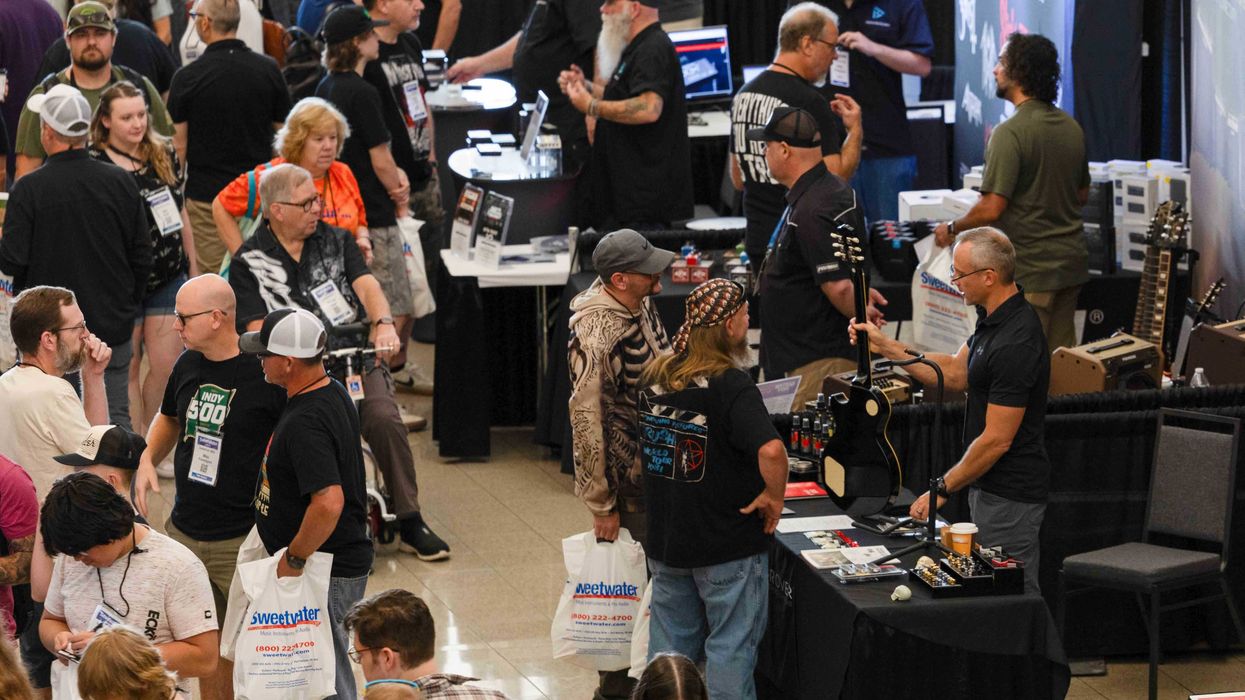
This past weekend, Sweetwater had the pleasure of welcoming guitar enthusiasts to our Fort Wayne, Indiana, campus for GuitarFest. The event featured over 70 manufacturer booths, more than 20 world-class guitarists, and numerous industry leaders, all coming together for a celebration dedicated to the guitar.
“It was an incredible event,” shared Samantha Hunter, Director of Artist Relations and Campus Productions at Sweetwater. “Music enthusiasts and guitar players had the unique opportunity to see up close the very latest gear and engage directly with the manufacturers. Additionally, fans had a chance to meet some guitar legends and collect autographs, creating lasting memories for all that attended.”
Held on Saturday, September 27, GuitarFest was a one-day event that drew several thousand music fans from all over the Midwest. The event underscored Sweetwater’s commitment to creating a community for music lovers and providing opportunities to share the passion of music.
Sweetwater is very appreciative to everyone who came together to make this event such a success. GuitarFest was made possible because of our partnership with our vendors, the artists, and our employees.
About Sweetwater
The number one online retailer for music makers, Sweetwater is trusted and beloved by millions of musicians, sound engineers, band and orchestra directors, and podcasters who rely on the company to help advance their musical and creative journeys. From beginners to rock stars, music makers everywhere seek out Sweetwater’s industry-leading expertise, including in-depth product videos to inform their purchases and unrivaled post-care support. Headquartered in Fort Wayne, Indiana, and founded in 1979, Sweetwater Sound, LLC credits its four decades of profitability to its now 2,500 employees and its deep understanding of the profound connection that music makers have with their craft, their gear, and the creative process. Sweetwater is amplifying change through music, lifting up communities by creating, empowering, and caring about the music makers of tomorrow and today. For more information, visit Sweetwater.com/.
Vernon Reid: Gathering Signals from Across the Musical Universe
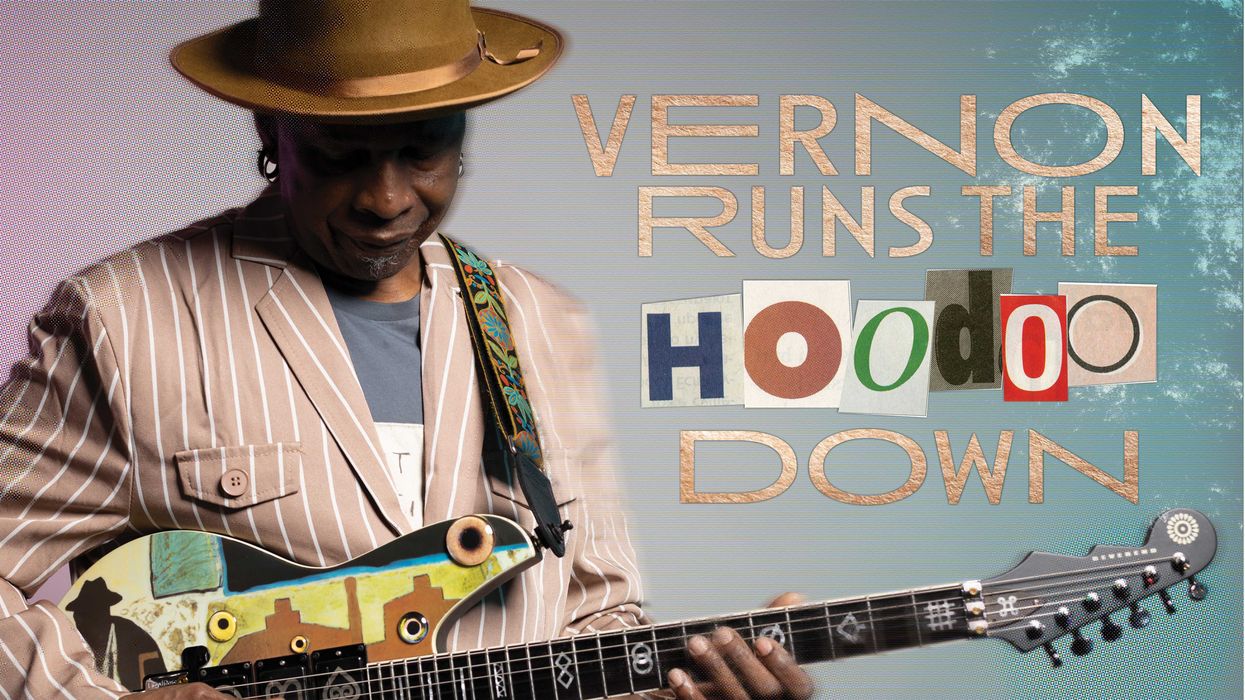
“Avant-garde, jazz, pop, rock ’n’ roll ... if some aspect of the human condition comes through in the music, that’s what animates me,” Vernon Reid says about his approach to sound. “It animated me before I even picked up the instrument. And it has animated me all the way through.”
It’s this unwavering commitment to human connection over stylistic boundaries that has defined Vernon Reid’s career—and it’s perhaps never been more evident than on his new solo album, Hoodoo Telemetry. Reid is speaking to Premier Guitar from what he calls the DharmaLab, his home studio on Staten Island. The name nods to the Dharma Initiative from the TV series Lost (“I’m a big fan,” he says), and like that show’s mysterious island, the Living Colour guitarist’s musical world follows its own rules, where seemingly disparate elements meet to create something entirely new.
Hoodoo Telemetry, his first album released entirely under his own name since 1996’s Mistaken Identity, embodies this philosophy. The title itself speaks to the collection’s nature: “hoodoo” suggests mystical forces and folk magic, while “telemetry” implies the gathering of information from distant sources. “I can understand why anyone listening to it would go, ‘This is all over the place,’” Reid acknowledges. “But I’ve kind of been all over the place, really, in every context I’ve been in.”
The path to Hoodoo Telemetry began years ago, pre-Covid, but that “huge interruption” fundamentally shaped the record’s final form. During those lockdown days, Reid found himself cycling over New York bridges, taking photographs, playing guitar, and contemplating where he wanted his music to go.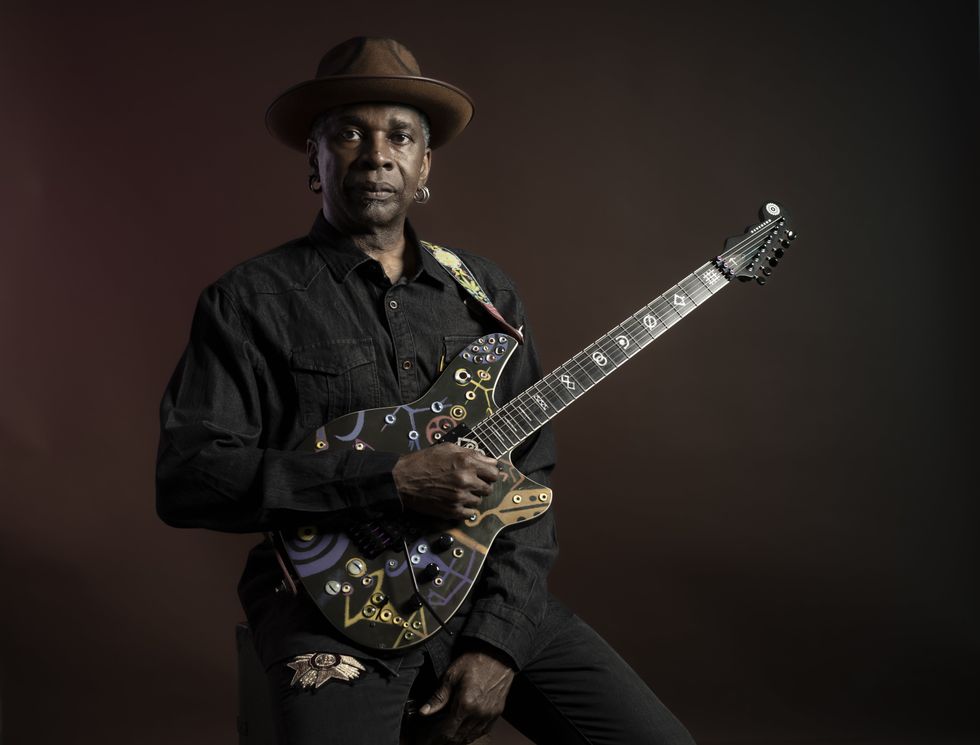
Then tragedy struck. Reid lost his close friend Greg Tate, the influential writer, guitarist, and critic who had been instrumental in his early career. Though Tate didn’t die from Covid directly, Reid considers him a Covid victim due to the stress the pandemic placed on the healthcare system. “We think about the victims of Covid as the people that had Covid themselves,” he says, “but there were plenty of other people that, if the healthcare system wasn’t strained by Covid, they would’ve have survived their situations.”
The loss proved pivotal. Tate had written the first serious article about Reid and his music, and the two had been co-founders of the Black Rock Coalition. Tate passed on December 7, 2021—the exact same date, Reid says, that the Black Rock Coalition held its first public event, in 1985. “It was a traumatic thing, and it sort of reframed or focused what I was doing—I wanted to make a record that Greg would like.”
Indeed, Tate’s influence permeates the album. Burnt Sugar, Tate’s experimental collective, is featured on three tracks, while Reid also says his friend encouraged him to sing more (which he does, on the track “In Effigy”). “[Greg] said, ‘Man, you have a quality to your voice,’” Reid says. “‘You have a thing,’ you know?”
There are other elements woven throughout Hoodoo Telemetry. “Part of the thread in the album is the idea of the diaspora—the idea of being adrift,” Reid says. This is reflected from the first track, “Door of No Return,” which draws on the historical term for the final passage of enslaved Africans leaving their homeland for America, to the closing number, “Brave New World,” which takes its title from Aldous Huxley’s cautionary dystopian novel. “Where’s the center, right?” he continues. “Especially when you realize the trip is a one-way trip.”
Musically, the album has an eclectic and adventurous spirit. There’s “Politician,” Reid’s take on the Cream classic. The choice reflects both personal history—Reid played the song with Jack Bruce in the band Spectrum Road—and contemporary relevance. “It’s my favorite Cream tune,” he says. The sentiment behind it, meanwhile, is “an evergreen thing,” he continues, “what with these jive so-and-sos….”
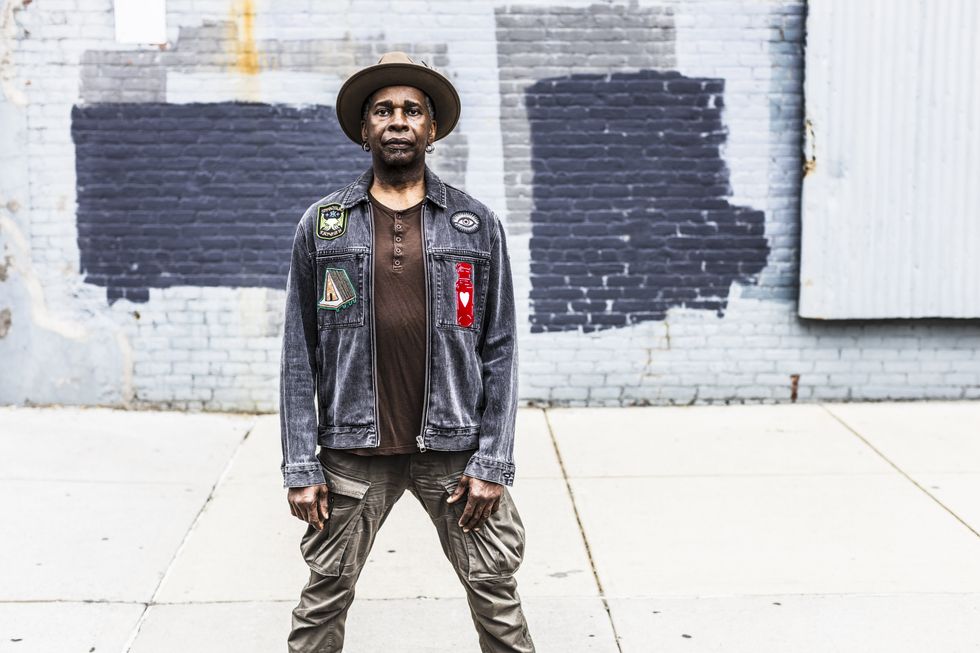
“Ever since I saw Clapton with The Fool, I’ve loved guitars with graphics.”
Another song, “Freedom Jazz Dance,” emerged organically during recording sessions at Super Giraffe Sound in Brooklyn. Originally planned as an instrumental, the tune transformed when Burnt Sugar vocalist Bruce Mack suggested incorporating Eddie Jefferson’s vocalese version. The result became what Reid describes as “this kind of ‘60s sci-fi version of the song.”
Perhaps most poignant is the skittering, atmospheric “Good Afternoon Everyone,” built around a found vocal recording Reid captured in the subway, where a homeless man repeated the same request with unchanging inflection: “Good afternoon, everyone. Can anybody help me with something to eat today?” What initially seemed like mere politeness revealed itself as controlled anger. “I realized, okay, he’s enraged. He’s not just being polite,” Reid says. “But his affect didn’t change. It was really chilling and really poetic.”
The track exemplifies Reid’s approach to social commentary through music. Collaborating with rapper Nironic, “Good Afternoon Everyone” explores homelessness from multiple perspectives. “One of the things [Nironic] did was that he pivoted,” Reid says. “At one point, he’s the person ignoring the homeless person, and then he flips, and he’s also the person seeking aid. I thought that was pretty cool.”
While Reid’s conceptual concerns drive much of Hoodoo Telemetry, his guitar work—the element that, of course, first brought him to prominence—remains equally compelling throughout, expertly balancing furious blasts of technical prowess with emotional expression. Reid can shred with the best of them, but he’s equally capable of restraint when the music demands it.
The contrast between tracks like “Door of No Return” and “Brave New World” illustrates this philosophy. The former demands intensity: “‘Door of No Return’ is really about a kind of feeling,” Reid says. “It’s a certain energy. It’s about loss, it’s about rage. It’s about figuring out, where do I go from here? You’re not going back home. And that requires a certain kind of approach.” Meanwhile, “Brave New World” prioritizes melodic content over flash. “That little guitar melody in the song is more important to me than the solo,” Reid says.
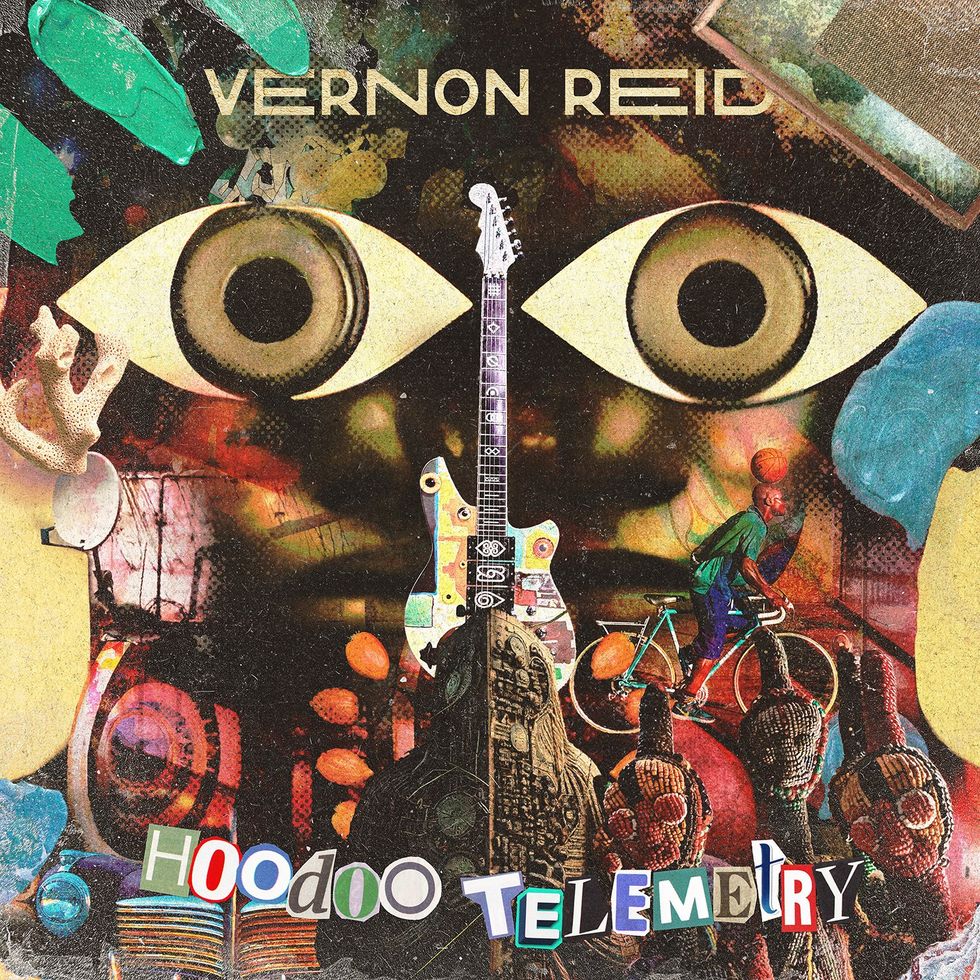
“If you think something is impossible, there’s no way forward.”
For Reid, it’s all about understanding and serving the musical moment. “What does music mean, and what’s the right thing to do for a particular song?” he says. “There are times I can sit there and go, ‘Okay, I wanna play this, and the song could be just a vehicle.' But there’s a balance. Because, man, playing fast is thrilling. But figuring out an approach against a harmonic background, or improvising something, that’s thrilling, too. And at the same time, it has to work for the song. Something like ‘Good Afternoon Everyone,’ that’s not a song for a flash solo. It’s a song for a vibe. That’s one of the things I loved about Prince. He always got that. Because somebody like that, you can do whatever. But the question is, why?”
“Meditation on the Last Time I Saw Arthur Rhames” serves as perhaps the album’s most personal statement (as well as a vessel for some of Reid’s wildest, most thrilling lead playing), honoring the avant-garde New York City-based musician who profoundly influenced Reid’s understanding of guitar possibilities. “Arthur Rhames used to play stuff at Prospect Park [in Brooklyn],” Reid says. “And it was only when I heard Allan Holdsworth that I said, ‘Oh, that reminds me of what this guy in Brooklyn used to do.” The track combines blues elements with modal, Coltrane-influenced improvisation, “and there’s also influence from Sonny Sharrock and Pete Cosey, especially when he was playing with Miles [Davis], doing that super psychedelic, heavy, mysterious thing,” Reid says. “One of the things I love about Miles in that period is he wasn’t trying to explain. He was like, ‘You either got it or you ain’t get it.’”
When it comes to the actual guitars on the record, Reid points out that the recording of Hoodoo Telemetry mostly predates the arrival of his current signature Reverend model, drawing instead from his extensive collection of instruments accumulated over the years. “Some of the stuff is my old Hamers,” he notes, referencing his custom Chaparral and the model he calls “Yin-Yang,” which appeared on multiple tracks. He also utilized his signature PRS S2 VR Vela, a Gibson ES-345, and a Stephen McSwain guitar with an aluminum flag top design that he nicknamed “Tuskegee.”
That said, his Reverend signature model does make appearances, notably on tracks like “In Effigy” and “Brave New World,” which were recorded more recently. The Reverend features his preferred V-shaped neck profile, a specification he’s maintained since his ESP days, as well as a trio of custom Railhammer humbuckers that he says are “pretty amazing for the way they take to overdrive and distortion.” Visually, the guitar reflects Reid’s affinity for striking graphics. There’s symbology inspired by the likes of Carl Jung, Joseph Campbell, and Jean-Michel Basquiat imprinted on the body, inlays in the shape of “hobo signs,” and pickup covers sporting African Adinkra symbols. “I wanted to put together something that was almost like an outsider art-type project,” Reid says. “And when we were coming up with the images and designs for it, what we wound up at was, why don’t we just do it as a series?”
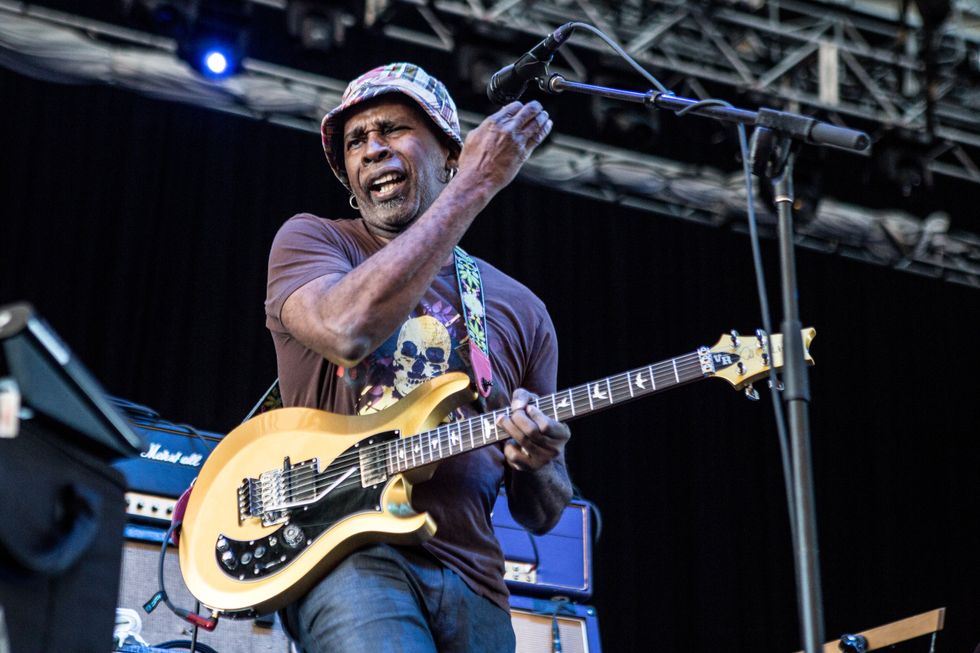
The collaboration with Reverend, which is known as the Totem Series, embodies his lifelong appreciation for guitars as visual art. “Ever since I saw Clapton with The Fool, I’ve loved guitars with graphics,” Reid says. “And I always loved stickering guitars. Because they are a canvas, you know?” And not just for him: “I recently ran into Jack White at Memphis Airport, and we wound up trading signature models,” Reid recalls. “I gave him a [Reverend Totem Series] Mystery Tramp, and he gave me a [Fender] Triplecaster. And then he did the same thing with Kirk Hammett—they traded signature guitars. I think it’s really nice when that can happen between players.”
Like Hammett and White, Reid is an iconic figure in the rock-guitar world. But if his success with Living Colour seems almost paradoxical given his deep roots—and experience—in jazz, experimental, and avant-garde music, he sees it as part of a natural continuum shaped by early exposure to diverse music. “My folks, they never told me what music I should or shouldn’t listen to,” he says. “The only thing they said to me was, ‘Turn it down—it’s loud!’ But they never said, ‘Don’t listen to that.’ I was never policed.”
Growing up in New York City also helped. Reid recalls going to “Music Row”—the stretch of 48th St. in Manhattan that for decades was home to famed gear outposts like Manny’s and Sam Ash—and rubbing elbows with the likes of Leon Russell, Mark Knopfler, and George Benson. “You would just see these guys walking around, and that made impossible things seem not completely unattainable,” he says.
Vernon Reid’s Hoodoo Telemetry Gear
Guitars:
Reverend Vernon Reid Totem Series “Mystery Tramp”
’90s-era Hamer Custom Chaparrals, including “Yin-Yang” model
Hamer DuoTone
Parker Fly VR Dragonfly prototype
PRS McCarty Semi-hollow
PRS S2 VR Vela signature
Gibson ES-345
Stephen McSwain electric
Don Musser concert acoustic
Eko 6-string banjo
Amplifiers
Mesa Boogie Dual w/ Mesa cabinet
Laney Ironheart
Fender Twin
Kemper Profiler
Effects:
Line 6 Helix and Helix Floor
Line 6 POD Go
Eventide H9, H90, Rose
Chase Bliss Warped Vinyl HiFi, Generation Loss, and MOOD
Red Panda Tensor and Particle
Digitech XP-300 Space Station, FreqOut, Whammy Ricochet, and DOD Mini Expression
Alexander Pedals Super Neo-Matic
Source Audio Nemesis and Collider
Mission Engineering Expressionator
Roland VG-99
Boss SY-300 Guitar Synthesizer
Software
Ableton Live
Pro Tools
Native Instrument Guitar Rig
“Playing fast is thrilling. But figuring out an approach against a harmonic background, or improvising something, that’s thrilling, too.”
New York was instrumental to Living Colour’s development as well. “Living Colour happened because of CBGB,” he says. “Without CBGB, we wouldn’t have built our local following. And that also goes for the Ritz, the Cat Club, the Mudd Club, all these places. Living Colour wouldn’t have happened without me playing with Ronald Shannon Jackson and the Decoding Society,” he says of his time with the downtown avant-jazz collective. “And the reason why it wouldn’t have happened is because, from that, I learned it’s possible. That’s it. That’s the whole point. Because if you think something is impossible, there’s no way forward. I mean, nobody should play the lottery, right? Nobody should play Powerball. Logically, it’s a fool’s errand. Except for the fact that people win, right?”
That notion of possibility against the odds is what drives Reid’s continuing musical evolution. Even as he unleashes Hoodoo Telemetry, he’s assembling “a small but mighty ensemble” featuring longtime collaborators Leon Gruenbaum on keyboards and Steve Jenkins on bass for upcoming shows, including a performance at the Blue Note in New York City. And then there’s a new Living Colour record on the horizon, which, Reid says, “We’ve been in the process of writing,” as well as the possibility of performing music from his solo albums, stretching from Hoodoo Telemetry all the way back to Mistaken Identity. “It would be really fun to do that with the band,” he says. “And I’m excited about all of it. I’ve just gotta thread the needle, and away we go.”
VegaTrem Introduces VT1 Special With Brass Block
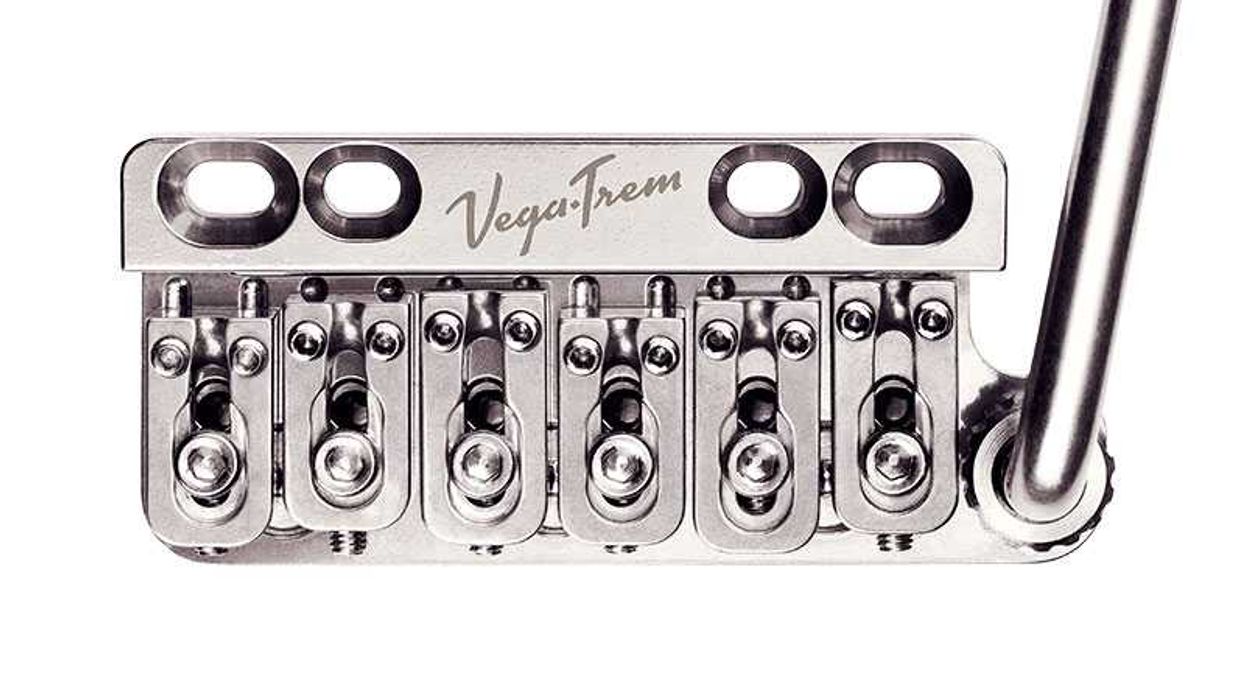
VegaTrem has unveiled the VT1 Special, a new take on the company’s iconic VT1 UltraTrem blueprint.
The VT1 Special utilizes a new brass block at its core, offering a friendlier price point while retaining all the key attributes that have made VegaTrem an essential choice for so many guitarists: it can be installed while keeping your guitar completely intact, and offers wide tonal range, simplicity and rock-solid tuning.
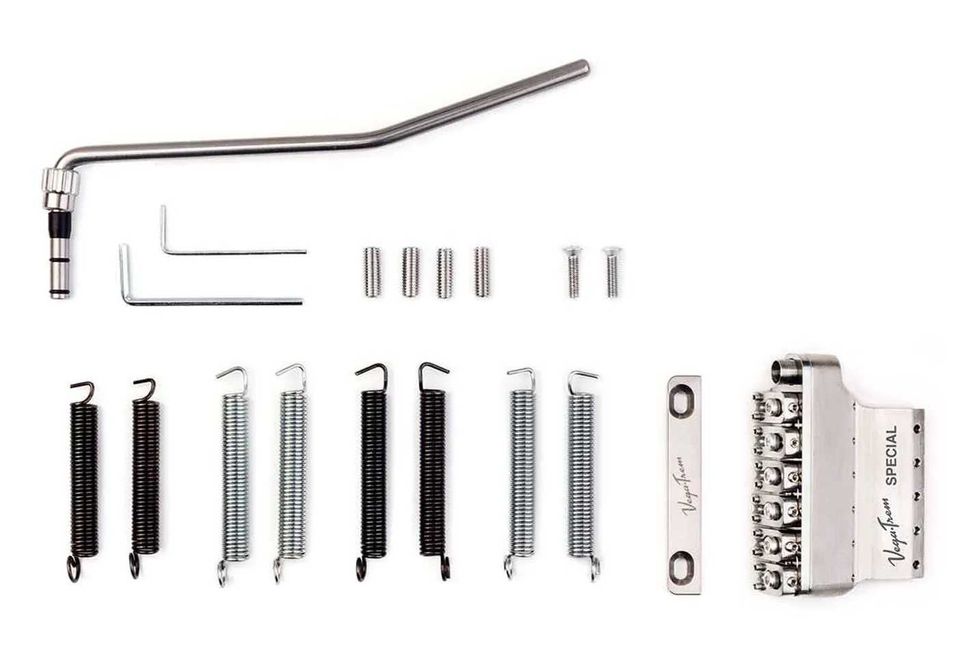
The VT1 Special is available in standard (6-screw) and 2-point versions in four different premium finishes (Glossy, Gold, Black, Satin) with left-handed options.
‘We at VegaTrem have reverential respect for all those guitarists that have given us so many great moments,” says Isaac Vega, guitarist and VegaTrem founder. “VT1 Special is our way of opening the door of the VegaTrem tremolo spirit to even more players—no drilling, no sanding, no surgery.”
By adopting a premium brass block, the new VT1 Special delivers a distinctive timbral palette that broadens the musical possibilities of the VegaTrem tremolo family—while preserving the hallmark feel and stability players expect from VT1.
The VegaTrem VT1 Special is available starting at $199 USD / €170 and can be purchased from dealers worldwide and at vegatrem.com.
Kirk Hammett co-founded pedal brand KHDK Electronics is now making guitars

Kirk Hammett co-founded pedal brand KHDK Electronics has branched out into guitar building, with a range of new models debuted at the recent Guitar Summit 2025 in Mannheim, Germany.
While info is relatively sparse at this time, we do know that the guitars unveiled sport some unconventional shapes, which some commenters have picked up on…
That said, it looks like some of the shapes are inspired by classic designs, including a model reminiscent of a Les Paul with P-90 pickups and Bigsby vibrato, an Explorer-style model, and what looks to be an SG-inspired double cut.
In response to one user on its Instagram post unveiling the guitars, who wrote, “I’m so sick of copyrights, all it does is make companies release ugly guitar shapes,” KHDK simply replied: “We love ugly guitars.”
As we say, information surrounding spec sheets for these guitars or pricing is few and far between at this stage, but we’ll endeavour to keep you in the loop as we know more…
Founded in 2012 by Kirk Hammett and collaborator David Karon, KHDK has, until now, been a pedal brand, with signature stompboxes designed for the likes of Deftones’ Chino Moreno, Anthrax’s Scott Ian and Avenged Sevenfold’s Zacky Vengeance.
The brand’s foray into electric guitars is a bold one, and a move not often undertaken by pedal brands.
Visit KHDK Electronics for more information as it comes out.
The post Kirk Hammett co-founded pedal brand KHDK Electronics is now making guitars appeared first on Guitar.com | All Things Guitar.
“I’ll never forget the sound of 82,000 people singing back at me”: Watch Sophie Lloyd open the Women’s Rugby World Cup Final with a 5-minute shred medley

Last weekend, Sophie Lloyd opened the Women’s Rugby World Cup Final with a stunning five-minute shred medley, before the game that would ultimately see England triumph over Canada.
In an Instagram post uploaded shortly following the event, the guitarist calls the occasion “one of the proudest moments of my life”, adding: “It felt like such an empowering day for women everywhere and I’m so honoured to have played a part in it.”
Now, speaking to Metal Hammer, Lloyd reveals that she was entrusted by organisers to “take their vision into my hands and create something new”. “I loved the song choices and had the best time composing the arrangement,” she says.
“Walking onto that pitch, I could really feel the support of everyone there, it was such a powerful moment of unity. Rock and roll has a way of bringing people together, and I’ll never forget the sound of 82,000 people singing Livin’ on a Prayer back at me.
“The whole day felt bigger than music or sport; it was about women showing strength, power and unity on a global stage. It was incredibly empowering, and I’m beyond honoured to have been part of it. Massive respect to every player who left it all out on the pitch, and huge congratulations to the Red Roses for making history and bringing the cup home.”
Sophie Lloyd rose to fame posting shred videos of classic songs to her YouTube channel. Her considerable following – 1.25 million on YouTube and 1.3 million on Instagram at the time of writing – even caught the attention of superstar Machine Gun Kelly, who drafted her into his backing band in 2022.
For her World Cup final performance, Lloyd wove together a medley of several tracks, combining her own track Battleground with Bon Jovi’s hit Livin’ On a Prayer and Black Eyed Peas Pump It
This performance was a pit stop before Lloyd hits the road this month with Deep Purple’s Glenn Hughes, whom she’ll be playing with as a special guest on his Chosen Years tour, with dates across the UK starting in October.
The post “I’ll never forget the sound of 82,000 people singing back at me”: Watch Sophie Lloyd open the Women’s Rugby World Cup Final with a 5-minute shred medley appeared first on Guitar.com | All Things Guitar.
Tommy Emmanuel on Onstage Curveballs, Recording Stories & Tone Philosophy
The Certified Guitar Player chats (and jams) with John Bohlinger about recording his new album Living in the Light, detailing his philosophy on tone and live sound, his focus on song arrangements and melody, hitting the onstage curveballs, and why he’ll never retire from being happy (performing).
Visit StewMac: https://stewmac.sjv.io/APO2ED
“They were expecting him to say, ‘Can you turn the bass up?’ And he probably never did”: …And Justice For All producer says James Hetfield and Lars Ulrich “hated” that Jason Newsted was a Metallica fan
![[L-R] Jason Newsted and James Hetfield of Metallica](https://guitar.com/wp-content/uploads/2025/10/Jason-Newsted-and-James-Hetfield-of-Metallica@2000x1500.jpg)
Though one of the iconic records in the history of thrash and prog metal, Metallica’s landmark 1988 album …And Justice For All has not been without its critics, mostly pointing to the lack of volume on Jason Newsted’s bass lines.
The album’s producer Flemming Rasmussen has put forth several theories as to why the band opted for a reduction in bass volume, including last year when he suggested they did so to “get a reaction out of” Newsted, as he had joined the band as a fan.
Now, in a new interview with Chile’s Futuro [via Blabbermouth], Rasmussen explains that the lack of bass on the album may have been due to James Hetfield and Lars Ulrich wanting to better hear their guitar and drum parts, respectively.
As the story goes, Rasmussen “had to say no to doing that album [at first]” because he was fully booked, and so the band worked with a series of “hotshot Los Angeles mixers”.
“They started it out with Mike Clink,” he says. “And then three weeks into January, after they’d been in the studio for three weeks, Lars called me up and said, ‘Oh, Flemming, when can you come?’ And I put all my sessions together and postponed some of them. And I went over there [on] 14 February and recorded for five months.
“And by the time I got there, they already got some hotshot Los Angeles mixers, Steve Thompson and Michael Barbiero, to mix it.”
Rasmussen explains how the band listened to what those producers had done, and said: “no, no, no. Where’s my drum sound? Where’s my guitar sound?”
“And actually Lars said, ‘Now take the bass down so you can just hear it,’” he continues. “They did that… And then once [they’d] done that, he said, ‘Take it three dB more down.’ So, it’s Lars and James that decided, and why they did that, I’ve asked them a thousand times. I do not know.”
Flemming Rasmussen also doubles down on his assertion that the band didn’t like that Jason Newsted joined Metallica as a fan.
“I think the reason why they turned the bass down is, like 50 percent of it is because they were on tour with Van Halen, and they flew in and heard the mix,” he goes on. “And I think that’s the point where Lars and James realised that, ‘We don’t have Cliff anymore. It’s not his bass. It’s a totally different sound.’ And I just think they couldn’t relate to that at that point…
The other half is what they hated most about Jason was that he was such a Metallica fan, so every time they asked him anything, he just did it. So I think they took it down just to piss him off, ‘cause they were expecting him to say, ‘Can you turn the bass [up]?’ And he probably never did. That’s why the bass is so low. But I don’t know.”
Despite its lack of bass volume, …And Justice For All has cemented itself as one of the most classic metal albums of all time, hosting tracks like One, Harvester of Sorrow, Blackened and Dyers Eve.
The album’s mix has even prompted some savvy fans, though, to ‘fix’ the audio by ramping up Jason Newsted’s bass parts. Check out this fan-remastered version of Blackened below, and compare it to the original:
The post “They were expecting him to say, ‘Can you turn the bass up?’ And he probably never did”: …And Justice For All producer says James Hetfield and Lars Ulrich “hated” that Jason Newsted was a Metallica fan appeared first on Guitar.com | All Things Guitar.
Meet Man/Woman/Chainsaw, the London art-punks who love jamming with their dads and chasing the perfect BPM

For a while there, it seemed like solo stars were keeping the music industry afloat. Think Taylor Swift’s Eras tour or Beyoncé’s Renaissance. But if this summer’s festivals are anything to go by, then guitar bands are back — in a big way. Take the post-pandemic pop of Isle of Wight wonders Wet Leg, who amped up their two-piece into a full-blown fivesome. Or Fat Dog, dubbed “the wildest band in Britain,” pushing punk with skronking sax and onstage hi-jinks.
Now from the same South London scene comes Man/Woman/Chainsaw, a six-person art ensemble fusing virtuoso violin lines with the furious tempo of a Black Midi backline. For guitarist Billy Doyle, the shift towards these sizable setups was inevitable. “It’s turning away from that 2000s-2010s indie sound of four-piece, all-male bands. Like, how fucking wacky can we get? In five years, people will say, ‘What the fuck was going on in the 2020s with all the six-piece bands?’” “With saxophone and timpani,” quips frontman/guitarist Billy Ward.
Despite the band’s eclectic output, bandleaders Ward and bassist Vera Leppänen bonded at school over the classic riff catalogue. “My first riff was Smoke on the Water,” laughs Leppänen. “My dad made me learn a lot of KISS songs. We jam a lot together, and still do that whenever I see him.” Meanwhile, Ward was picking up Nirvana before stumbling upon their more angular counterparts. “When we started the band, it was a lot more chaotic. Sonic Youth was a big touch point for tunings,” he recalls. You can hear those nods in last year’s Ode To Clio single, which alternates four and five-bar phrasing as the track builds to a frenzied crescendo. But it’s how these cleverly mastered moments land with the crowd that spurs the sextet on.
“There are moments when we’re writing things,” explains Ward, “and we think, ‘Okay, that’s where the drama is, and then we do it live, and the audience responds to a totally different bit!” Doyle noticed the impact on stage, too. “When you see people responding to a song, it’s a big adrenaline kick. Trying to remain composed with your playing is tricky when you’re excited by watching people move around.” Leppänen insists there could be more of that, though. “At Boomtown, I tried to figure out the BPM that made people move — around 120. But people don’t wiggle enough at our shows.”
Stacked Up
Last year’s Eazy Peazy possesses a few possible crowd-swellers. Recorded in Eastbourne’s Echo Zoo Studio with Gilla Band’s Dan Fox, the five-track EP found the group digging into the playbox, feeding violinist Clio Harwood’s strings straight through full guitar stacks and a sub bass and cranking up the vintage Selmer amplifiers, despite the lack of master volume. “If you turn them up, they sound better!” admits Ward. “But the most fun thing was the Watkins Copicat tape echo. There’s a lot of that to drive the guitar and the violin by cranking the preamp.”
Ward’s obsession with bending sound extends to his instruments too. “My first proper guitar was a Fender Player Jaguar. I still think a Jaguar is the coolest-looking guitar, especially with the plates.” Not content with the off-the-rack model, though, Ward began experimenting. “I’m such a perfectionist that I very quickly started to mod that guitar. I stripped the finish off it, painted it white, changed all the pickups, and the trem.”
The Frankenstein fettling didn’t go unnoticed in their South London setting, however. “Some asshole stole it from The Windmill about a year and a half into us doing shows!” he exclaims. “They just grabbed the case! But that’s fine. I hope they can never get the action right. I hope they’re making shit music with it, and may your riffs always suck.”
For all the sonic explorations, it’s easy to forget that Man/Woman/Chainsaw are still just a bunch of pals having a good time. Too much in some cases when I quiz Leppänen about her memories of the studio. “I had to leave for talking when we were doing overdubs,” she admits bashfully. “Because there are six people, right? Six teenagers, and then one person in there doing takes, and five people on the outside, talking shit, backseat producing, having a little wine. Then Dan’s like, ‘Guys, I actually can’t work. You need to leave!’”
 Image: Sophie Barloc
Image: Sophie Barloc
Shifting Perceptions
If Eazy Peazy saw the group capturing their lairy live energy, then this year’s double A-side ManDog/Adam&Steve sees the collective sharpening those chaotic compositions and leaning on a more traditional rock and roll bedrock. A notable shift from his early Thurston Moore-inspired soundscapes, as Ward explains. “I quickly realised that alternate tunings come with a big bag of problems, and you could just get a big swamp of notes. Now I always stay in standard, and it’s more classic guitar stuff like The Rolling Stones.”
That’s true of the players’ latest instrument choices, too. Ward’s handling a fresh-looking tomato red Stratocaster on our call while Doyle remains loyal to his Telecaster, inspired by players like King Krule and Radiohead’s Jonny Greenwood. Leppänen began on a Wunjo Bass-bought Tanglewood, but after a few early Chainsaw shows, the then-sixteen-year-old musician needed an upgrade. “I said to my dad, ‘Look, I’m in this band. We should probably get me an instrument!’ We got the ESP LTD Surveyor in pearly white.”
Since then, and thanks to the band’s inclusion in this year’s Fender Next Class of 2025 series, she’s added a new number to her live set-up. No awkward pitching necessary. “I’ve always wanted a P-bass,” she beams. So, as studious members of the latest class, what would the Chainsaw string section say is their greatest learning from life on the road so far? Ward’s learnings come straight from the heart. “Don’t overcomplicate shit. You don’t need 10 million things to make your guitar sound clean or dirty. Your performance will be better if you simplify”.
While Doyle, the quieter of the trio, is more reflective. “Treat performances with a bad vibe like an actor would. Leave a shit day behind while you’re on stage.” And proving that Gen Z continues to transform the very premise of self-care, Leppänen adds deadpan. “It’s just self-care shit, and I don’t mean doing a face mask!”
The post Meet Man/Woman/Chainsaw, the London art-punks who love jamming with their dads and chasing the perfect BPM appeared first on Guitar.com | All Things Guitar.
Synergy Amps Launches the Marshall JMP Preamp Module
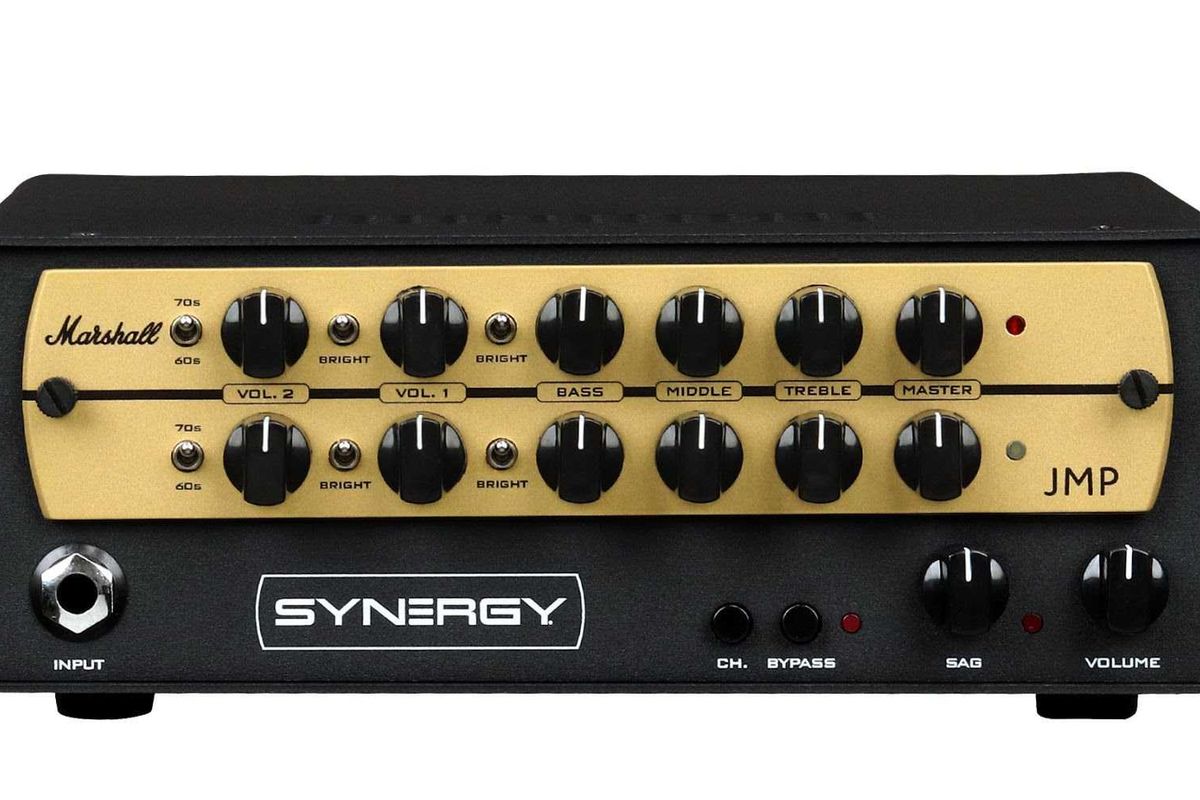
Synergy Amps today announced the release of the Marshall JMP Preamp Module, developed in partnership with Marshall Amplification. This all-tube, two channel module delivers the unmistakable growl, touch sensitivity, and dynamic response of the legendary JMP - now in a compact, modular format designed for today’s players.
From Eric Clapton and Jimi Hendrix to Jimmy Page, Eddie Van Halen, and Angus Young, the Marshall JMP amps have shaped the sound of rock for generations. With the new Synergy JMP module, guitarists can now harness that iconic Plexi tone at any volume, with the flexibility of Synergy’s modular system.
The JMP has always been about raw energy and expressive touch, and now players can access that authentic tone through the Synergy platform - without compromise.
The JMP module captures every nuance of the classic circuit with the following features:
- Dual 12AX7 preamp tubes for real-tube harmonics.
- Two independent channels with Volume 1, Volume 2, Bass, Middle, Treble, and Master controls.
- 1960s and 1970s voicing switches to replicate era-specific JMP tones.
- Four Bright switches to fine-tune treble response.
- Cathode Select switch for classic input tube configurations.
- An innovative “0-watt power amp” phase inverter design that replicates the feel and dynamics of a cranked Marshall head.
With the Synergy system, players can build their ultimate all-tube rig without sacrificing authenticity with modules from the world’s most coveted amp designers - Friedman, Soldano, Bogner, Fryette Engl, Diezel, Pavey, Dr. Z and now the most famous of them all – Marshall.
Pricing & Availability
The Synergy Marshall JMP Preamp Module is available beginning September 26, 2025, at an MSRP of $399.99.
For more information, visit www.synergyamps.com
Limited Edition Orange Amplifiers Rocker 15 & 32
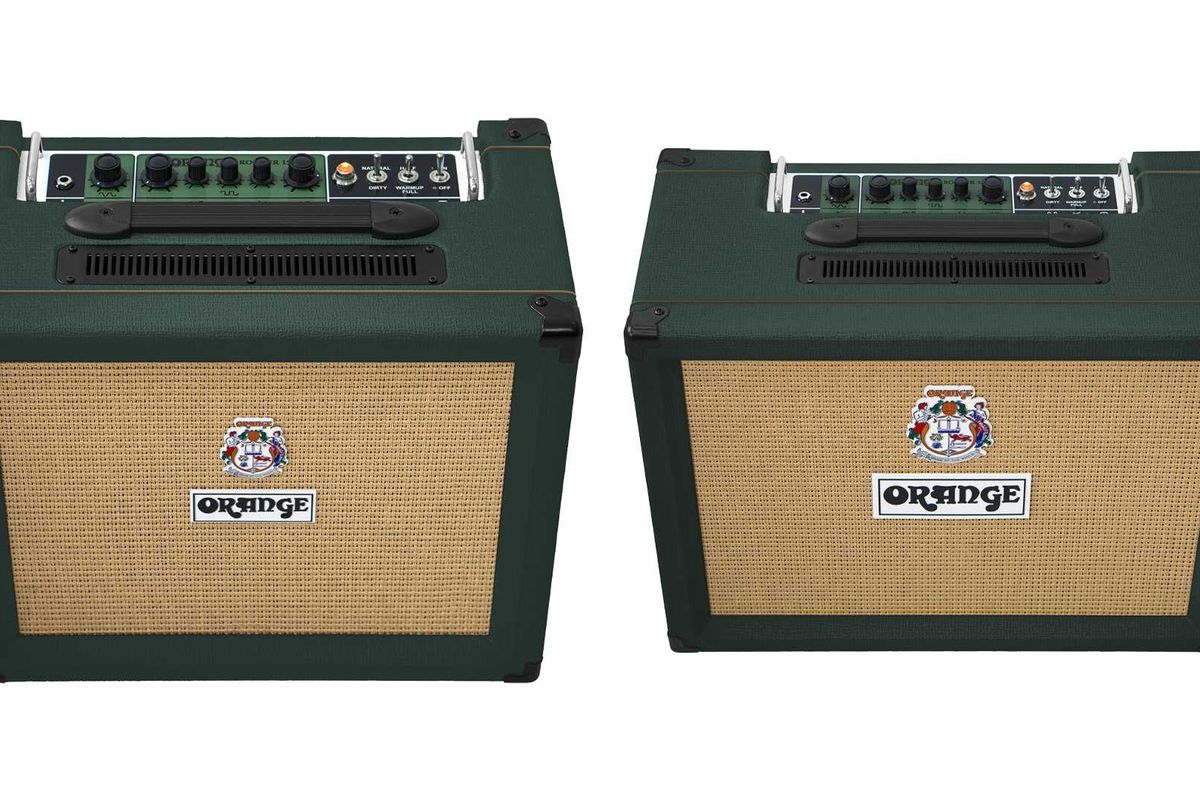
The Rocker 15 & 32, Orange Amplifiers’ amps for all occasions, are now available as a special Limited Edition in eye-catching British Racing Green featuring CELESTION G10N-40 speakers. Each combo comes with a Certificate of Authenticity, signed by Cliff Cooper, CEO and Founder of Orange Amps.
Both the Rocker 15 & 32 are deceptively versatile combos, suitable for many different venues and countless music genres. They are small, portable, two channel bedroom-friendly, all-valve amps you can legitimately gig with.
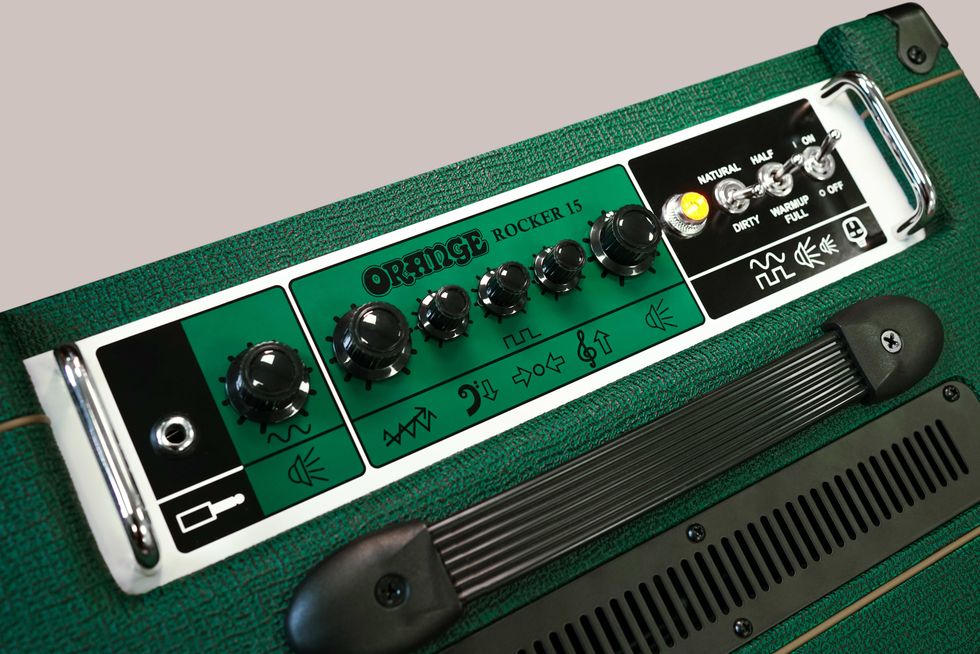
The small, two channel, all-valve Rocker 15 features a CELESTION G10N-40 speaker and beefy transformers for a potent delivery, which takes full advantage of its EL84 output section. Capable of 0.5,1,7,or 15 Watts of output, the portable combo, with a miniature footprint, oozes warm compression and fat, full tone. The twin channel output features a twist; the Natural channel is a purist’s dream voiced to bring out the ‘natural’ sound of the instrument being played, while the more familiar Dirty Channel offers plenty of British crunch. Its full and half-power switch, combined with the bedroom and headroom switch, means it is a home friendly amp that can be legitimately gigged with. It is available in a strictly limited quantity of three hundred units, worldwide.
Full of classic Orange mojo, the true stereo Rocker 32 has been fitted with two CELESTION G10N-40 speakers for a well-balanced tone with satisfying, deep lows right through to a well-defined top end. Its clever circuitry gives the amp a wide sound spread, while the stereo effect loop opens up limitless possibilities and makes it the perfect pedalboard partner. In particular, the ‘wet/dry’ option allows guitarists to play their effects through one speaker and the clean guitar tone through the other. The Natural channel clearly articulates every nuance of all guitar, pickup and pedal combinations. It has plenty of clean headroom and loves to be hit with overdrive and distortion stomps. The Dirty Channel with its balanced three band EQ, gain and master volume controls, offers a multitude of different British crunch flavours. Plus, it can be set to clean too! The handy half power mode can switch the Rocker 32 from the full 30 Watts down to a home friendly 15 Watts. Only eighty units will be available worldwide.
To find out more about the special Limited Edition Rocker 15 & 32 in British Racing Green, please go to www.orangeamps.com.
Engl Unleashes the Ravager IR Head and E412XXLK with Eminence Karnivore
ENGL Amplifiers proudly introduces the RAVAGER IR, a 20-watt, 2-channel tube amp that blends vintage tone with modern technology. Designed for musicians seeking a versatile, portable solution, the RAVAGER delivers exceptional sound quality in a compact lunchbox-style chassis.
The E725 RAVAGER use 12AX7/ECC83 in the preamp and EL84 in the poweramp section, producing dynamic, harmonically rich tones. Its dual-channel design provides pristine cleans and aggressive overdrive, making it ideal for stage, studio, or home use.
A key feature is its built-in IR Loader, enabling users to use four impulse responses (IRs), three of them can be loaded via USB for unparalleled cab simulation. This makes recording and silent practice effortless while delivering a professional sound. The amp is also equipped with an XLR output for live and studio applications, along with a headphone out for private practice. Additionally, the integrated Power Soak feature allows users to reduce output power for cranked tube tones at lower volumes, perfect for home or studio environments.
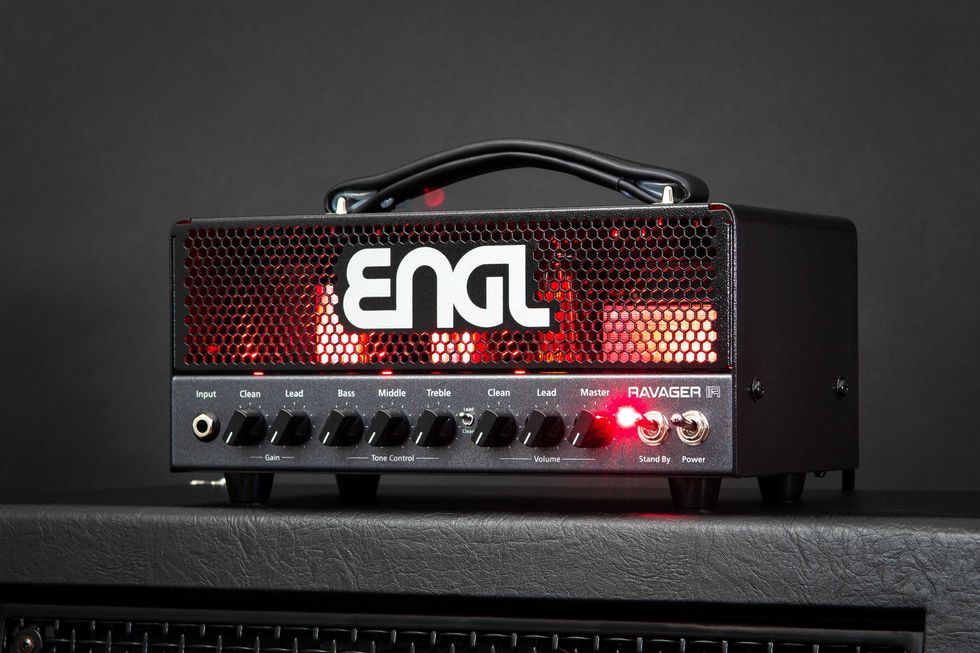
Key Features:
- 20W, 2-channel tube amp
- ECC83 preamp & EL84 power amp section for authentic tone
- Built-in IR Loader with four Irs (three customizable slots)
- USB connectivity for easy IR management
- Headphone output for silent practice
- XLR direct output for live and recording setups
- Integrated Power Soak for adjustable power (20 Watts, 5 Watts, 1 Watts, Speaker off) ∙ Compact, portable lunchbox design
E412XXLK Eminence Karnivore
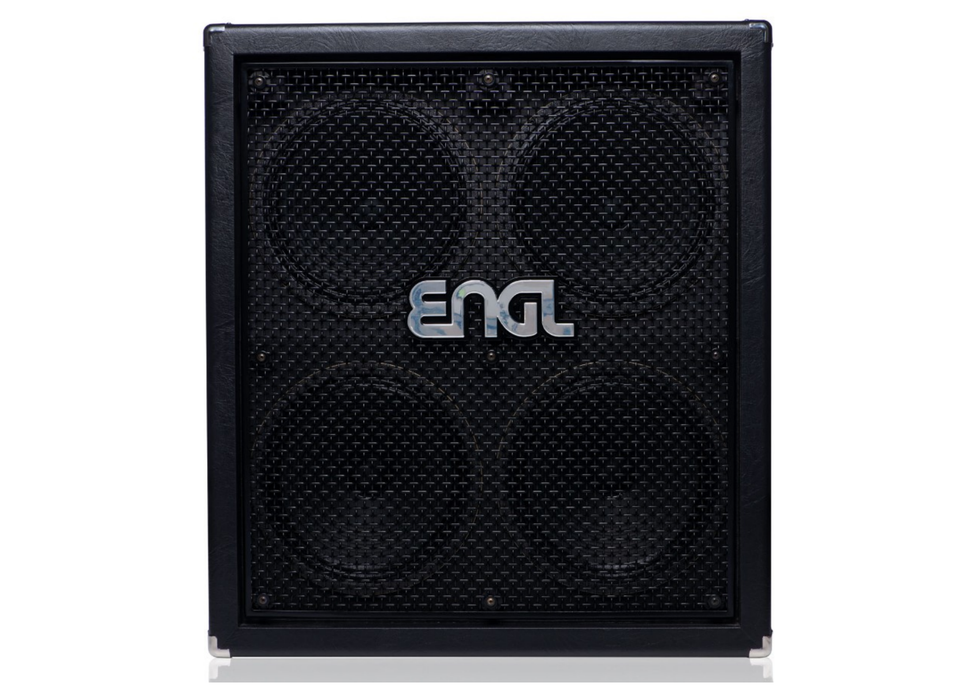
Engl unveils the new E412XXL with Eminence Karnivore speakers — a powerhouse 4x12"cabinet built to meet the demands of modern high-gain players. This updated version of the legendary E412XXL combines Engl’s precision-engineered oversized enclosure with the aggressive tonal character of the Eminence Karnivore speakers, delivering bone-crushing low end,razor-sharp attack, and exceptional clarity at high volumes.
Features
- Four Eminence Karnivore 12" Speakers
- Designed for modern metal and hard rock, offering tight bass, cutting mids, and controlled top end for maximum definition under high gain.
- Oversized Straight Cabinet Design
- Deep enclosure for massive low-frequency response and room-filling projection.
- High Power Handling
- 240-watt total power at 8 ohms, ready to handle the most powerful tube heads without breaking a sweat.
- Tour-Grade Construction
- Robust birch plywood build, reinforced corners, metal grille, and heavy-duty casters for reliable road use.
- Huge, crushing sound ideal for drop tunings and extended-range guitars ∙ Precise articulation at high volumes for tight rhythm work
- Designed from the ground up by Kristian Kohle and the Eminence engineering team, the Karnivore delivers all the bite and all the meat
Availability
The new E412XXL with Eminence Karnivore is available hrough authorized Engl dealers and distributors worldwide.
Rig Rundown: My Chemical Romance
After their Covid-delayed, smash-success reunion tour a few years back, My Chemical Romance plotted the Long Live the Black Parade North American stadium tour this past summer.
PG’s Chris Kies joined the run at Soldier Field in Chicago, and before the show, he rendezvoused with techs James Bowman, Josh Schreibeis, and Joe Saucedo—who handle Frank Iero, Ray Toro and Mikey Way’s rigs, respectively—for a look at the axes, amps, and effects the heavy-hitting emo titans are using these days.
Brought to you by D’Addario.
Dose of Castedosa
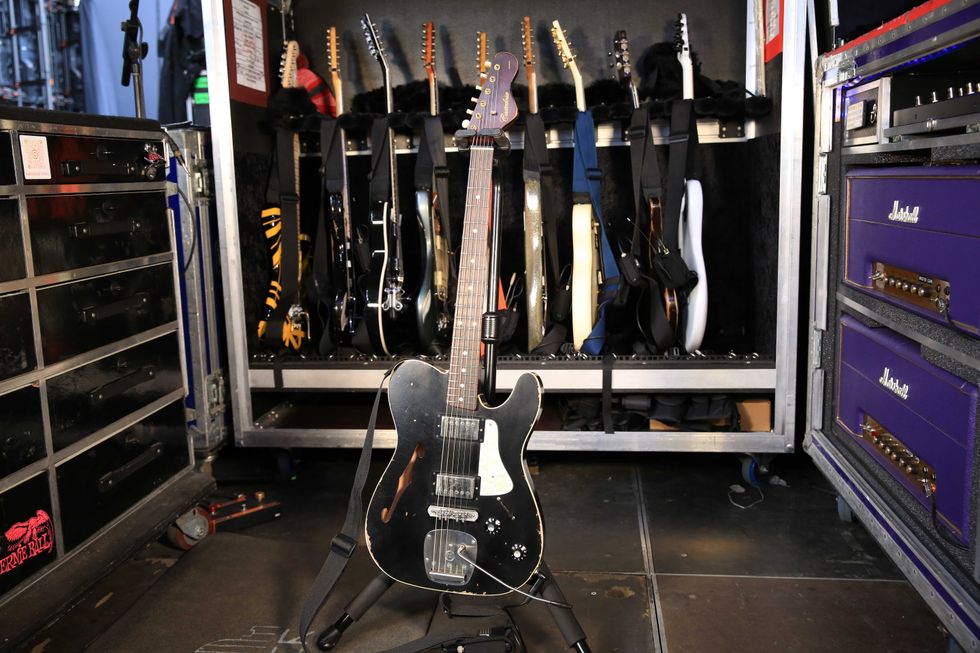
After Iero got this Castedosa Marianna Semi Hollow, it became the show starter for this summer’s tour. This, and all other guitars, are tuned down a half step with Ernie Ball Paradigm strings (.011–.052).
Bury Me in White
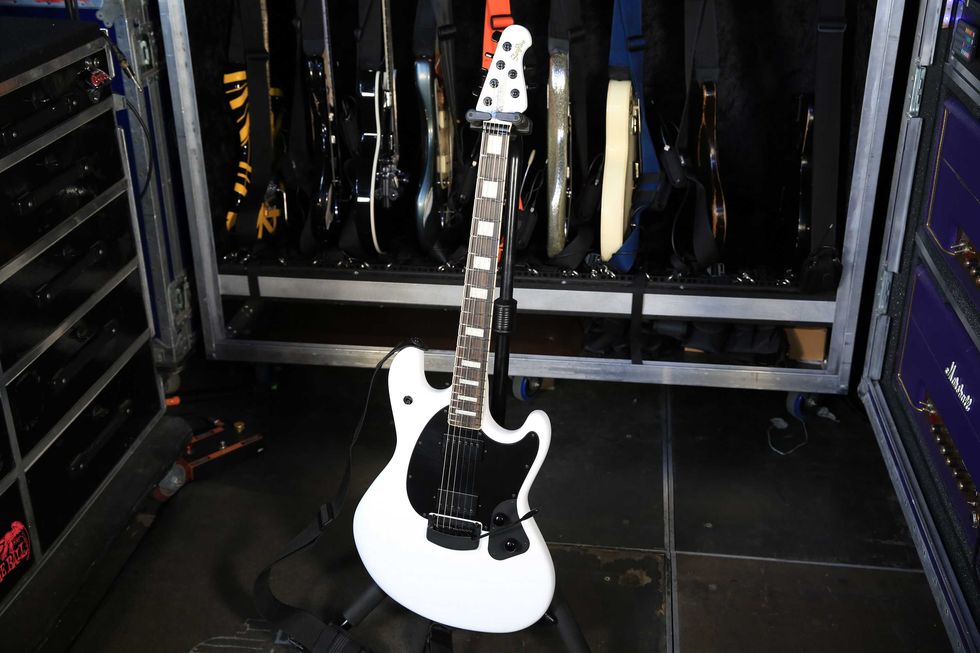
Iero favors Ernie Ball StingRays like this one, in matte “Stormtrooper” white. The only mod on this guitar is the addition of Luminlay dots on the side of the neck.
One and Done
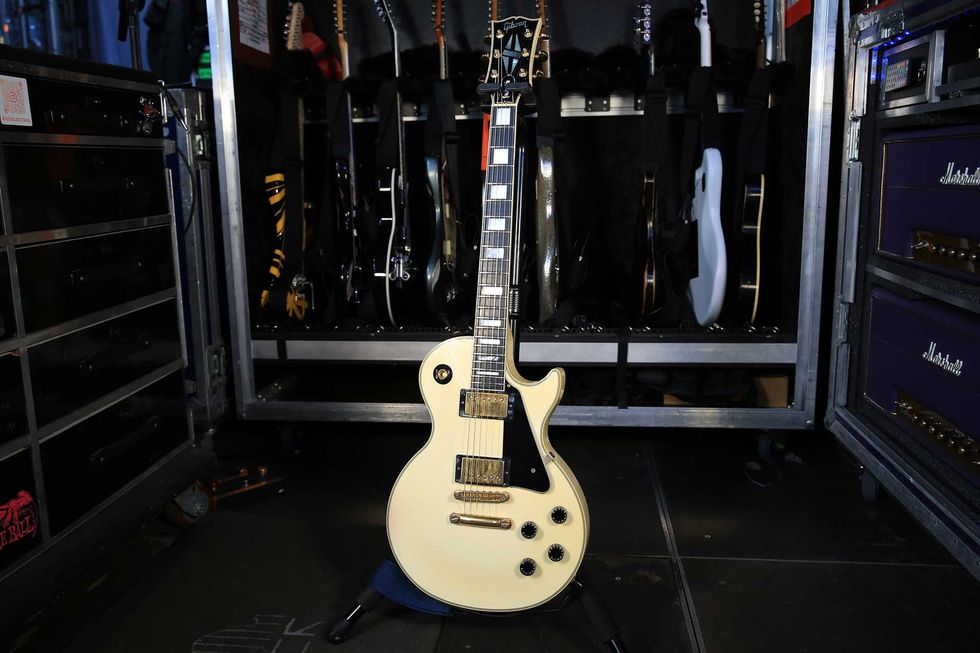
This 1992 Gibson Les Paul gets played only for the title track off the band’s 2006 record, The Black Parade.
Under Pressure
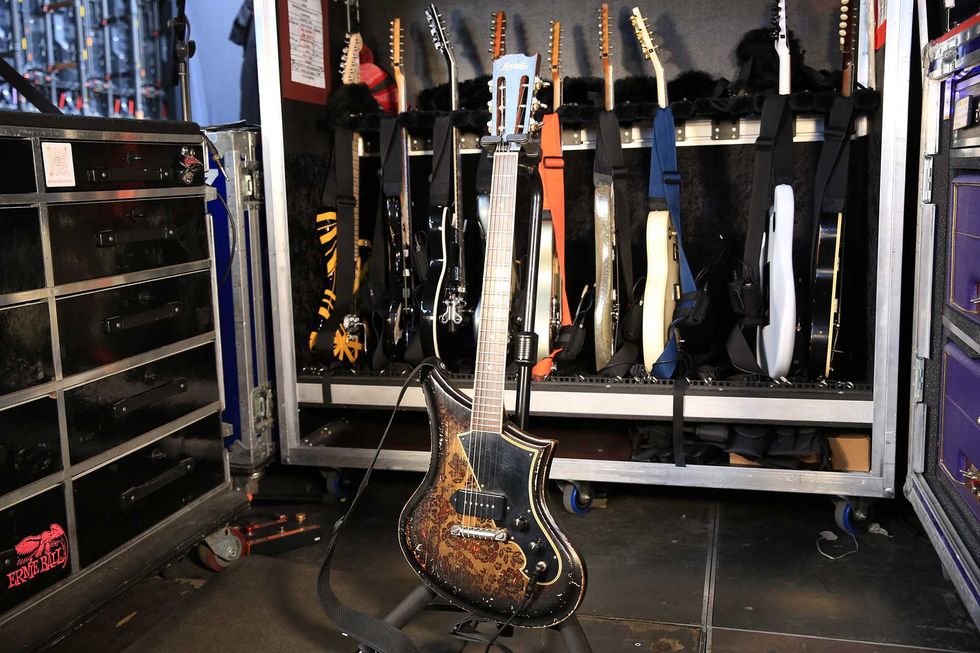
This tiny, light Abernethy Guitars electric takes Bowman forever to string. If anyone has tips, send them his way.
Purple Reign
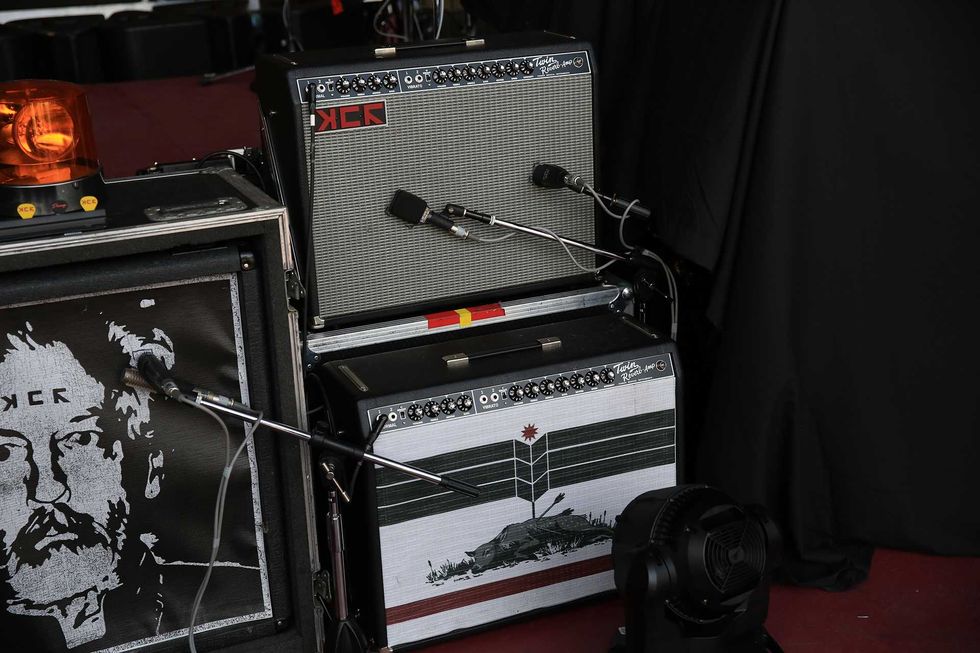
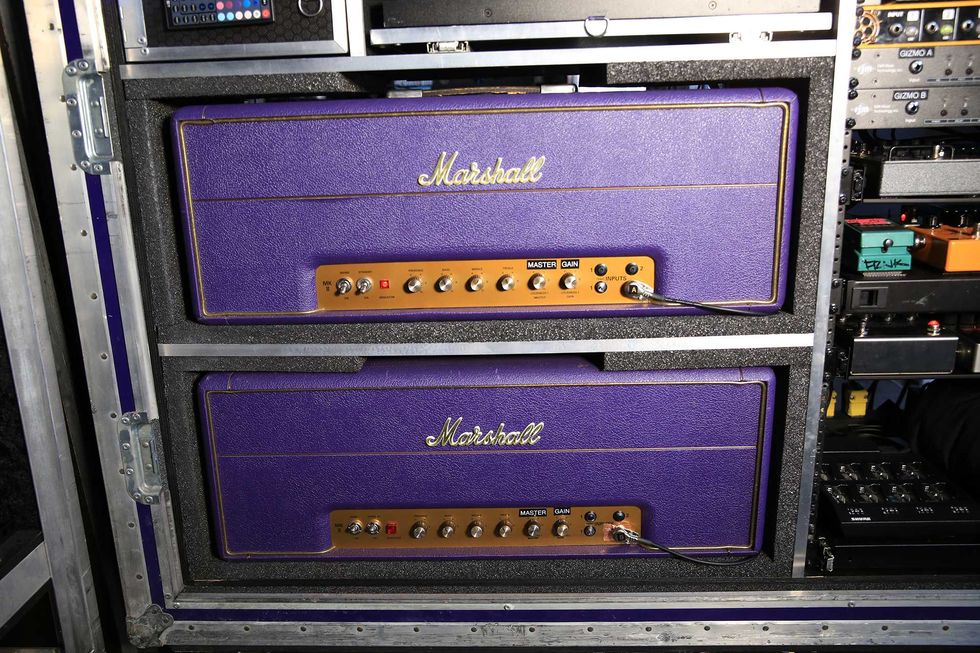
After using Marshall Super Lead heads with the Dookie mod on the previous tour, Iero found these slick purple heads and brought them to Dave Friedman to match the Dookie specs and add some EQ tweaks. These two, a main and backup, are responsible for the bulk of Iero’s sounds.
A Fender Twin Reverb onstage is responsible for “small-amp sounds,” while a Twin Reverb Tone Master underneath it sends a clean DI signal for the mix in Iero’s in-ear monitors.
Welcome to the Rack Parade
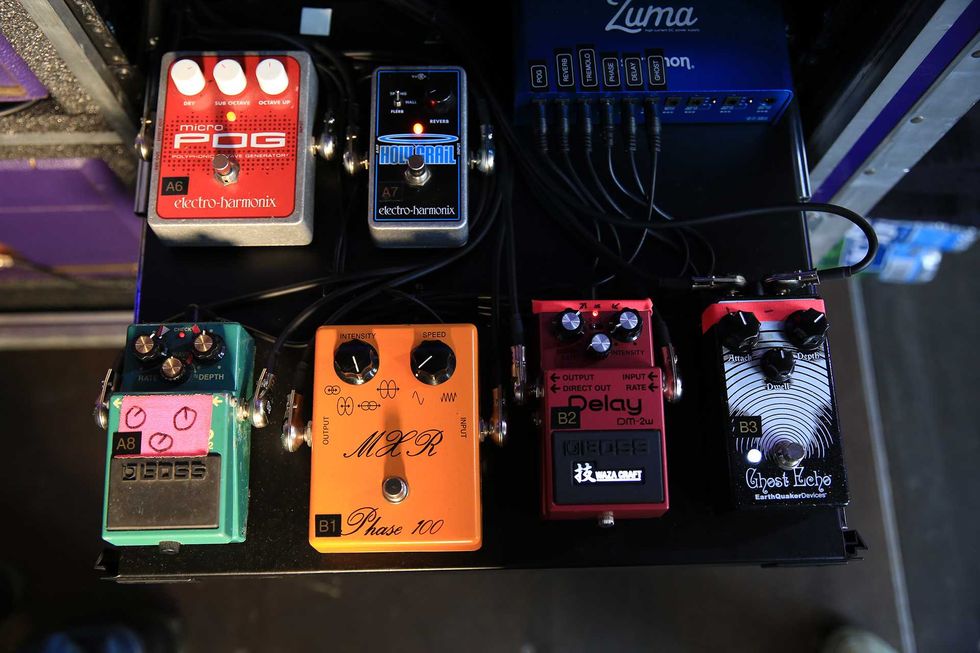
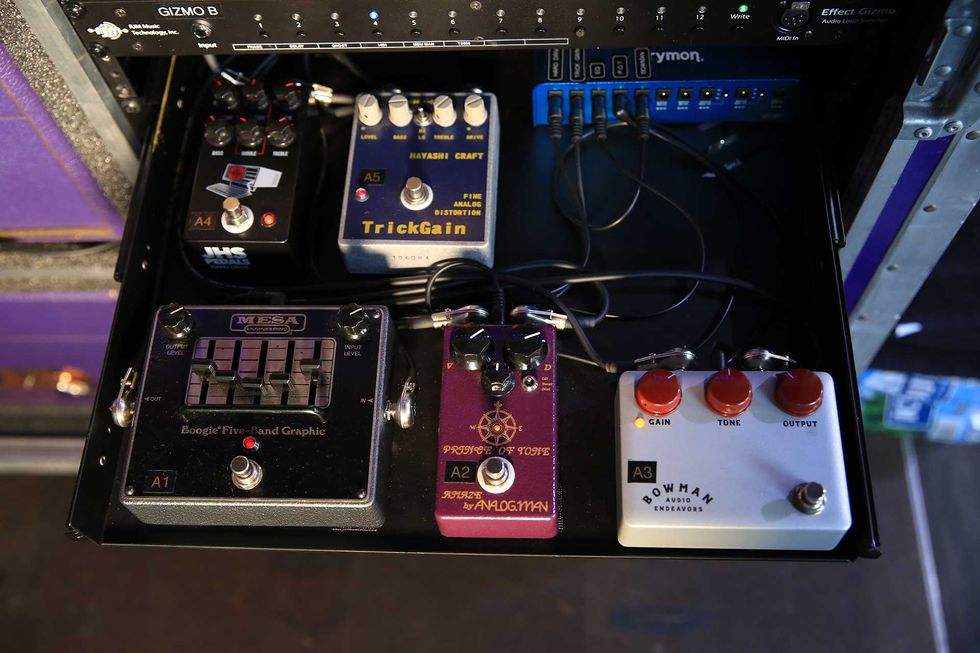
Iero’s backstage rack includes three main racks of effects, all powered by Strymon Zumas.
The first carries a Mesa Boogie 5-Band Graphic EQ, Amaze by Analogman Prince of Tone, Bowman Audio Endeavors Bowman Overdrive, JHS Hard Drive, and Hayashi Craft Trick Gain.
Drawer two is about modulation, and includes a Boss TR-2, MXR Phase 100, Boss DM-2W, EarthQuaker Devices Ghost Echo, EHX Micro POG, and EHX Holy Grail.
The last drawer bears a Jackson Audio Twin Twelve, EHX Deluxe Memory Man, Ibanez Tube Screamer Overdrive Pro, and Bowman Audio Bellyacher.
Toro’s Top
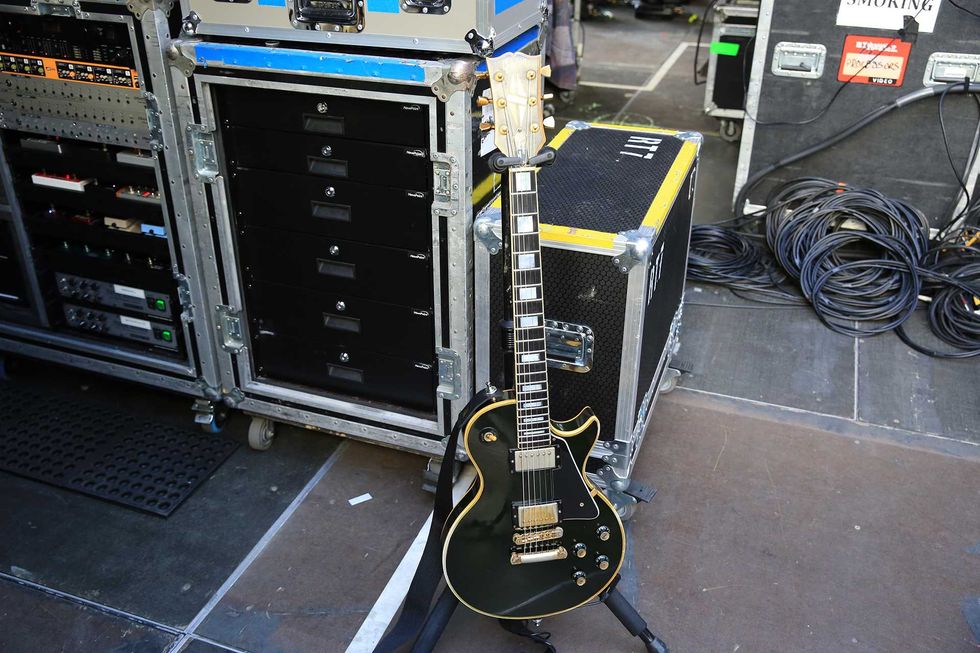
Toro plays this 1978 Les Paul to start the show, including tracks “The End.,” “Dead!,” and “House of Wolves.” He runs .011–.052-gauge strings on all his guitars.
Second Fiddle
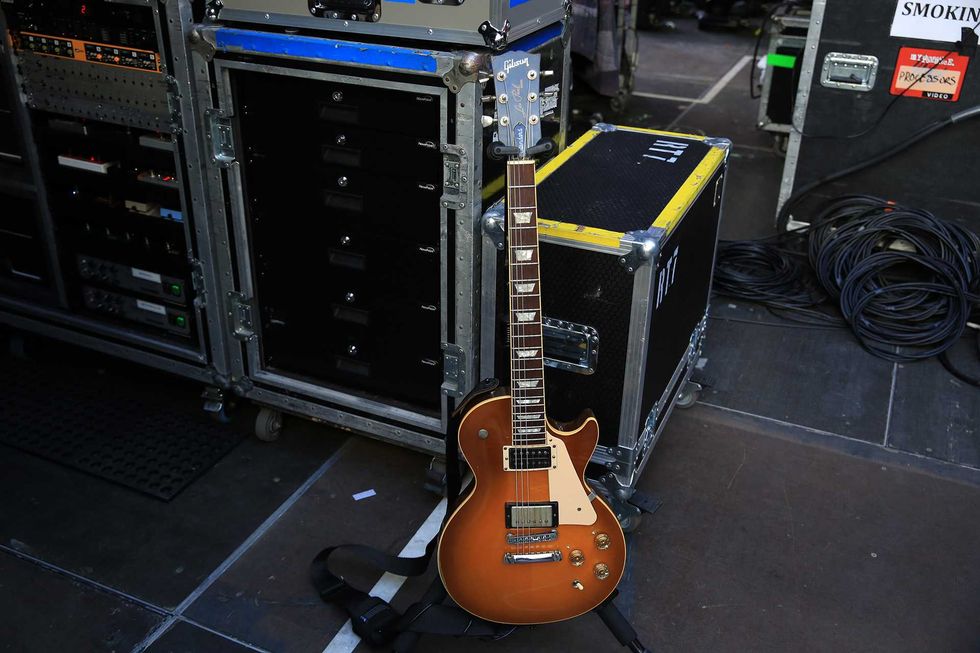
This sunburst Les Paul has been outpaced by the black ’78, but it still comes out for “Welcome to the Black Parade” and “Famous Last Words.”
Super 6
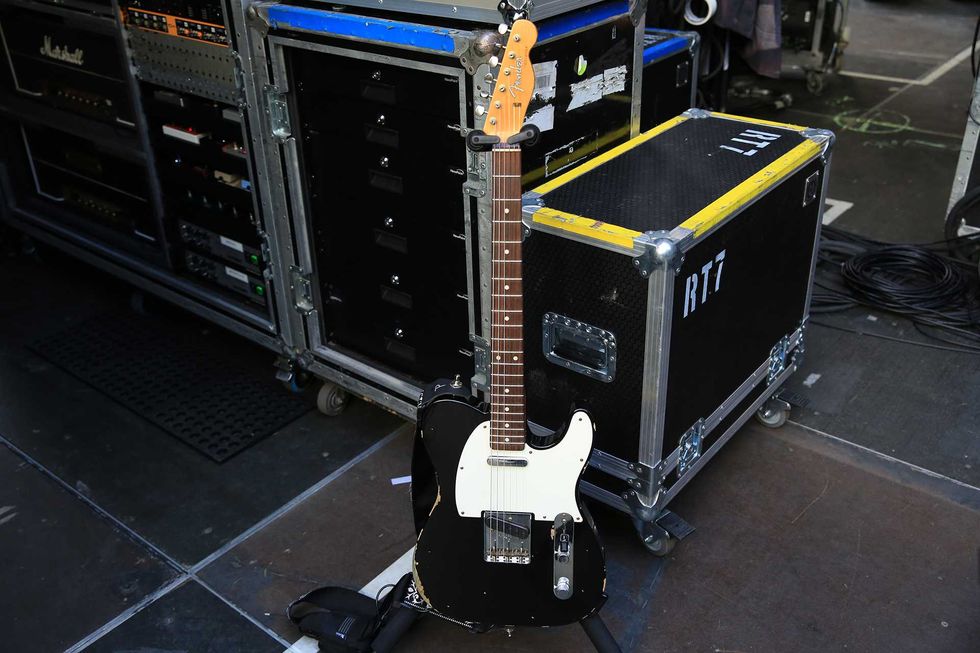
This 2005 Fender Custom Shop Telecaster sees action on six tunes in the band’s set.
Ray Toro’s Amps
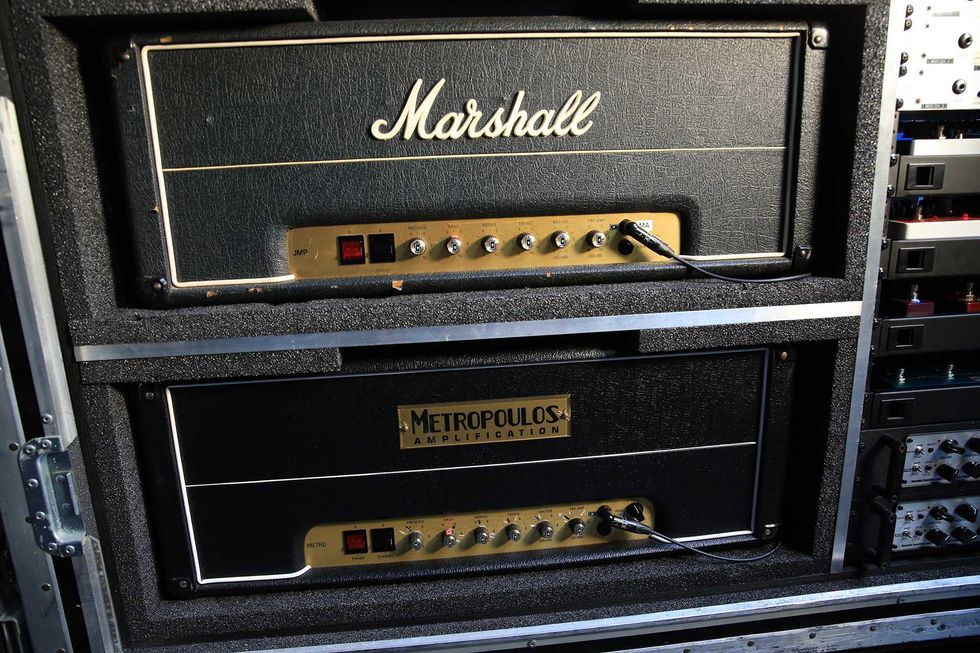
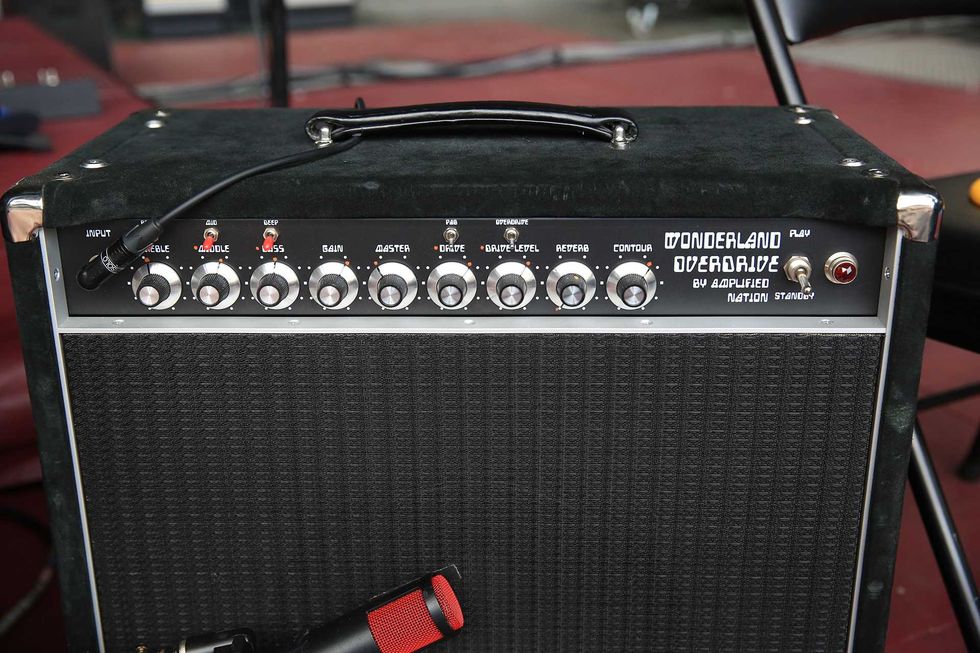
A head combo of a Marshall JMP and Metropoulos Amplification Metro (both running into Fryette PS-100s) comprise Toro’s main tones, while an Amplified Nation Wonderland Overdrive 1x12 combo is used for solo sounds, and a Fender Deluxe Reverb handles cleans. Toro’s signal is pumped through two 4x12 cabs—one Marshall, one Bad Cat.
Ray’s Really Rockin’ Rack Rig
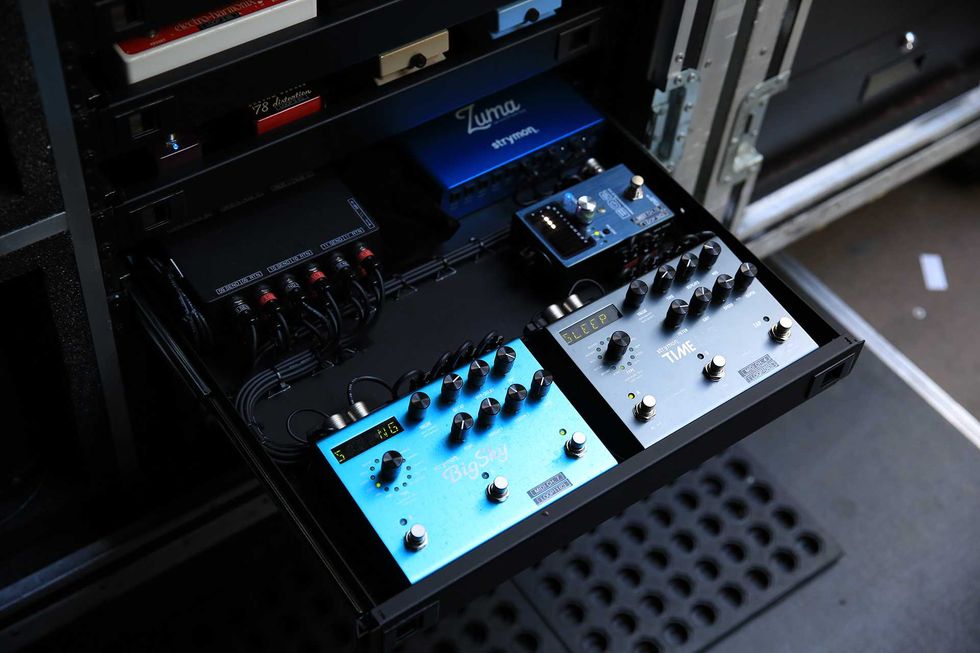
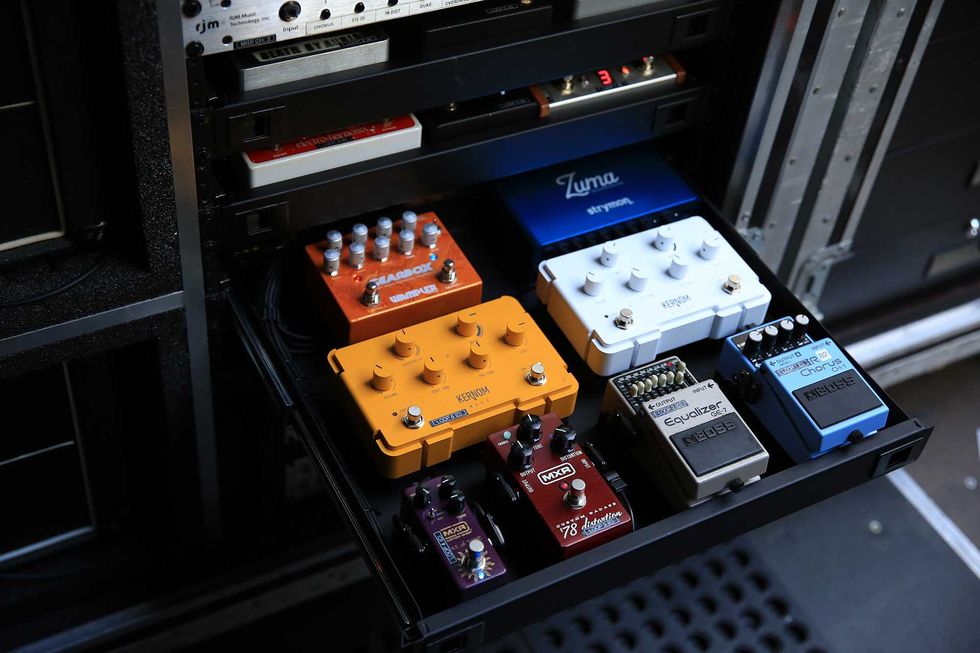
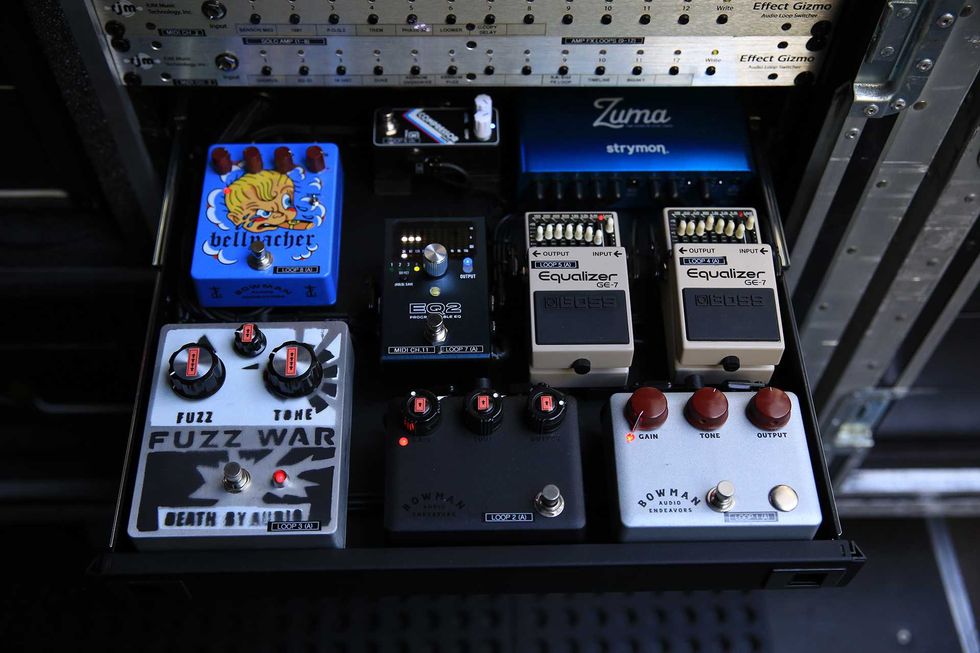
A Shure Axient wireless system sends his guitar’s signal to this system backstage, where it hits a Radial JX44 and a pair of RJM Effect Gizmos.
One drawer holds an MXR Duke of Tone, MXR Custom Badass ’78 Distortion, Boss GE-7, Boss CH-1, Kernom Moho, Kernom Ridge, and Wampler Gearbox.
In the next are two Boss GE-7s, two Bowman Overdrives, a Death by Audio Fuzz War, a Source Audio EQ2, a Bowman Bellyacher, and a Keeley Compressor Mini.
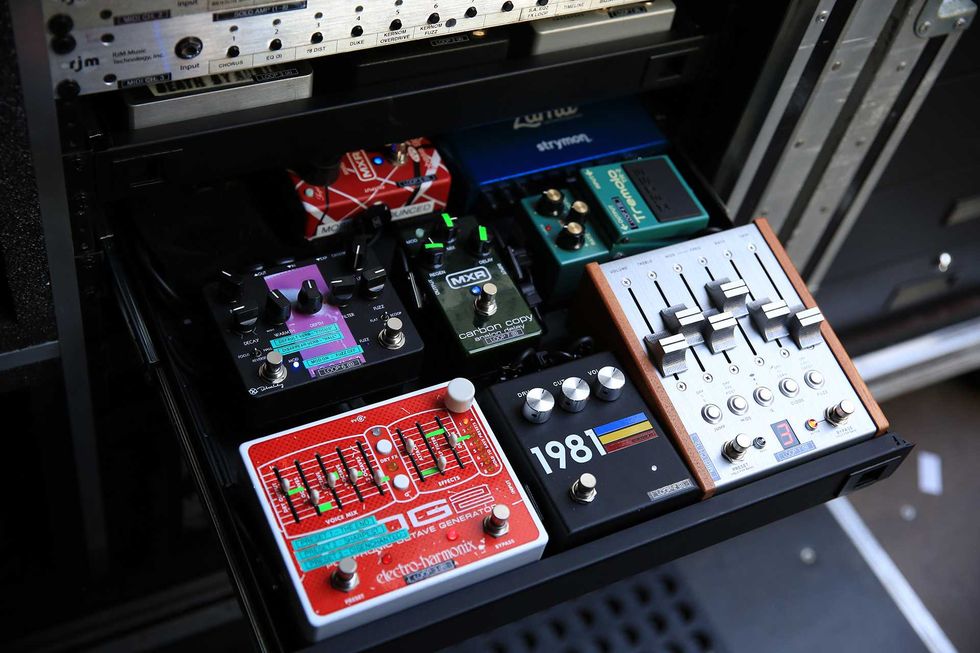
The third shelf is home to an EHX POG2, 1981 Inventions DRV, Chase Bliss Preamp MK II, Boss TR-2, MXR Carbon Copy, Keeley Loomer, and MXR EVH Phase 90.
A fourth level hosts a Strymon TimeLine, Strymon BigSky, and Source Audio EQ2.
Out onstage at his feet, Toro keeps a pedalboard with a TC Electronic PolyTune, a custom RJM Mastermind PBC/6X, Ibanez TS808, Bowman Audio Bowman Overdrive, EHX Micro POG, Boss TR-2, MXR Carbon Copy, and Strymon BigSky.
Strymon Zumas keep everything chugging along.
Comeback Kid
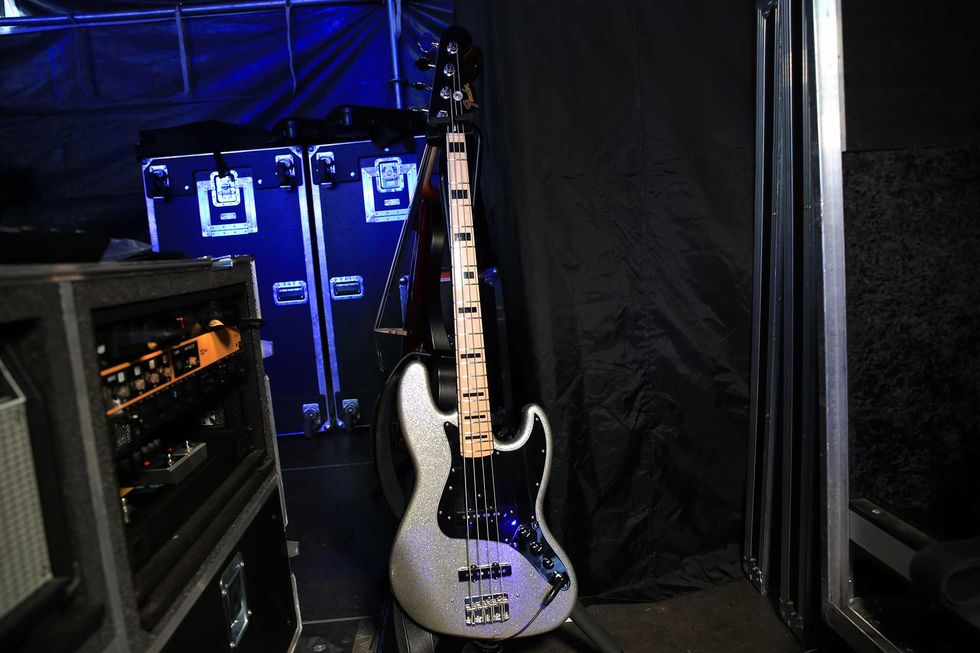
This silver-sparkle Fender Jazz bass was built for the band’s reunion tour, intended to mimic Way’s earlier signature model. It’s since been treated to more affordable Mexico-made production runs. Way runs Ernie Ball Hybrid Slinky strings (.045–.105) and plays with Clayton triangle picks.
Red!
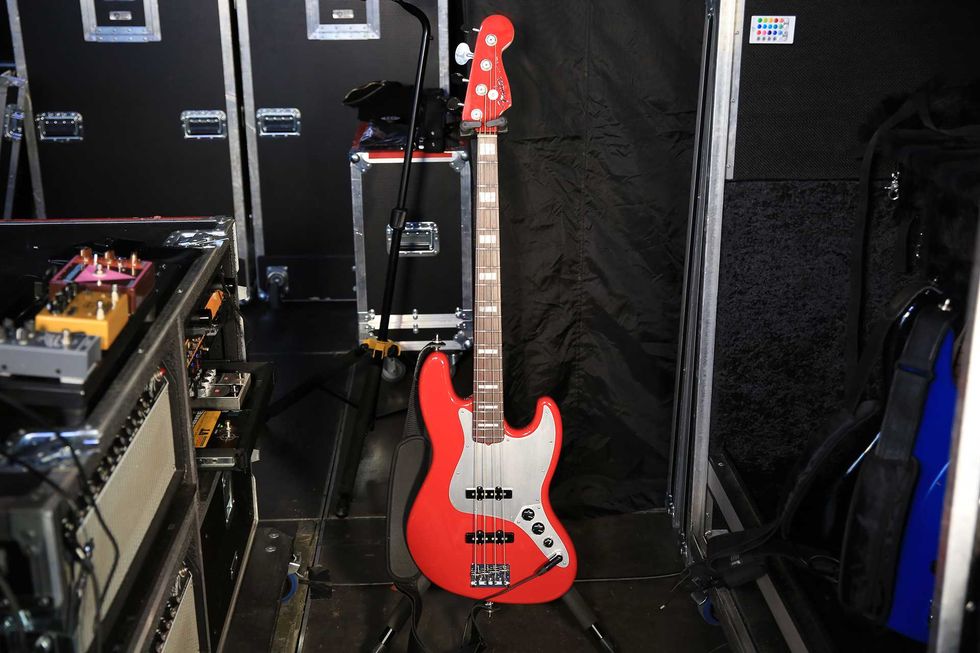
This eye-catcher was made by Fender’s Brian Thrasher, and is equipped with pickups from the Adam Clayton signature bass. Way relies heavily on this one, then switches to an identical one for down tunings.
Dodger That
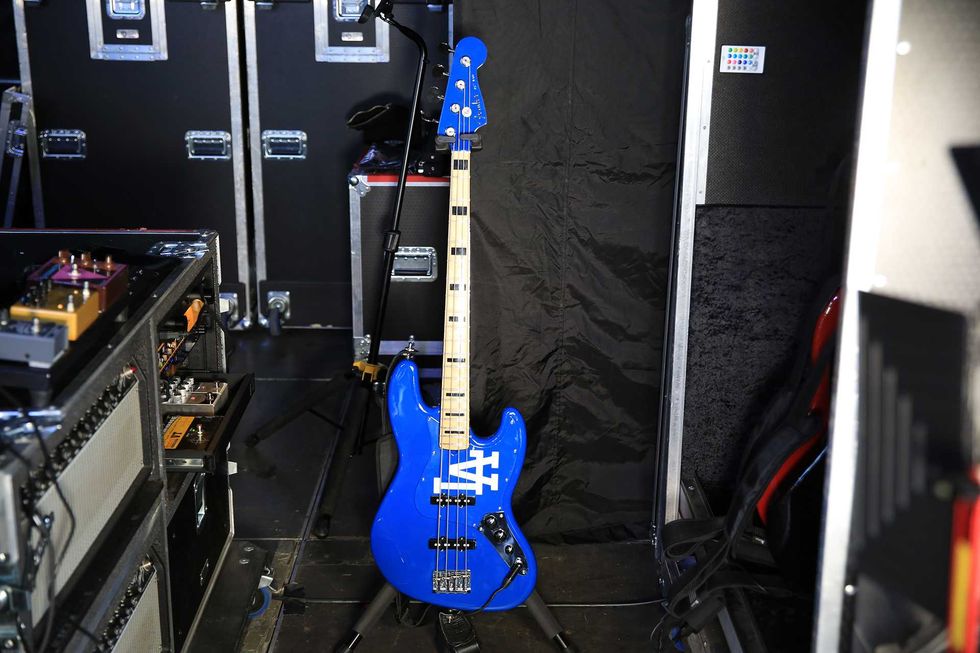
Way secured permission from Major League Baseball and the Los Angeles Dodgers to use the team’s exact hue of blue on this custom instrument.
Mikey Way’s Amp
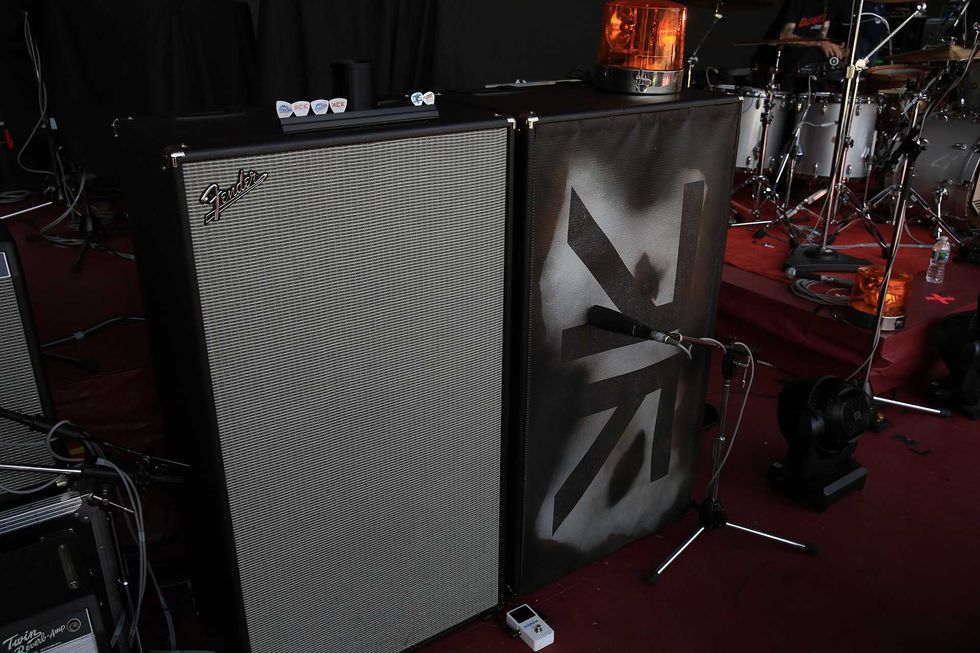
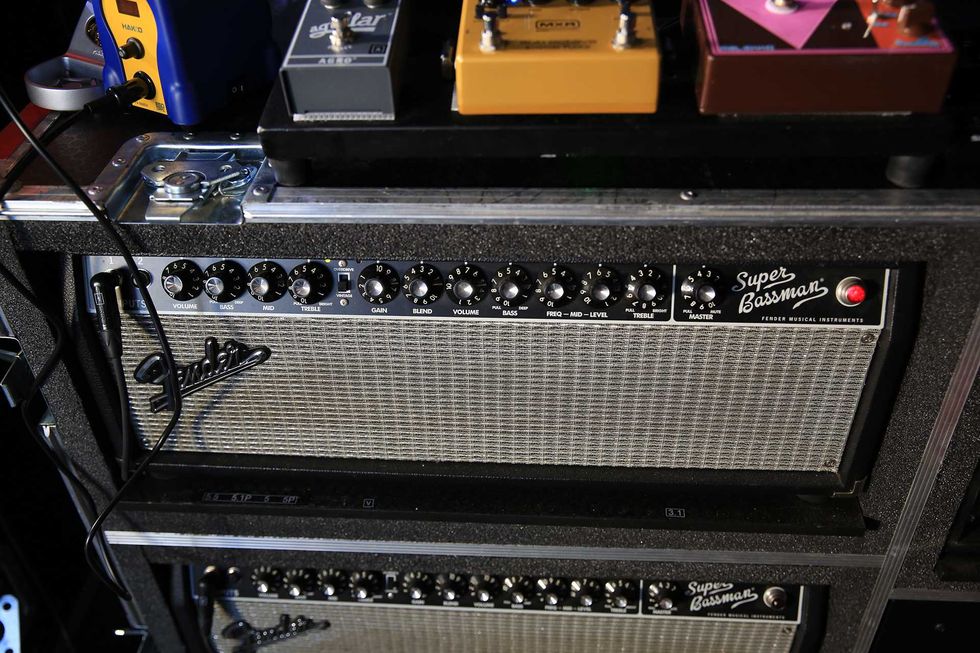
Way runs through a Fender Super Bassman head into matching 8x10 cabs, with a DI signal also running to front of house.
Mikey Way’s Effects
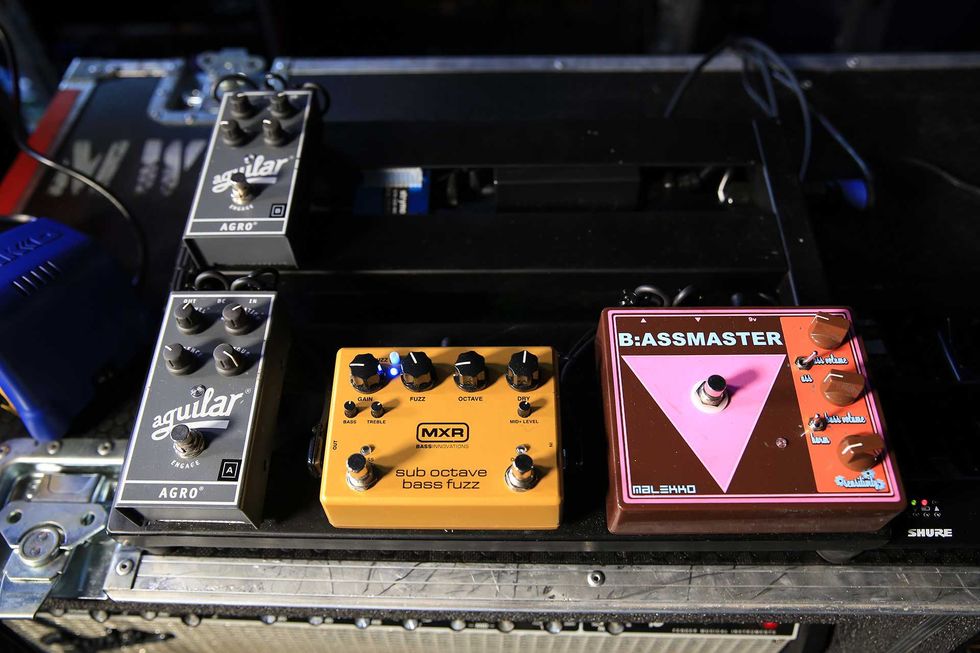
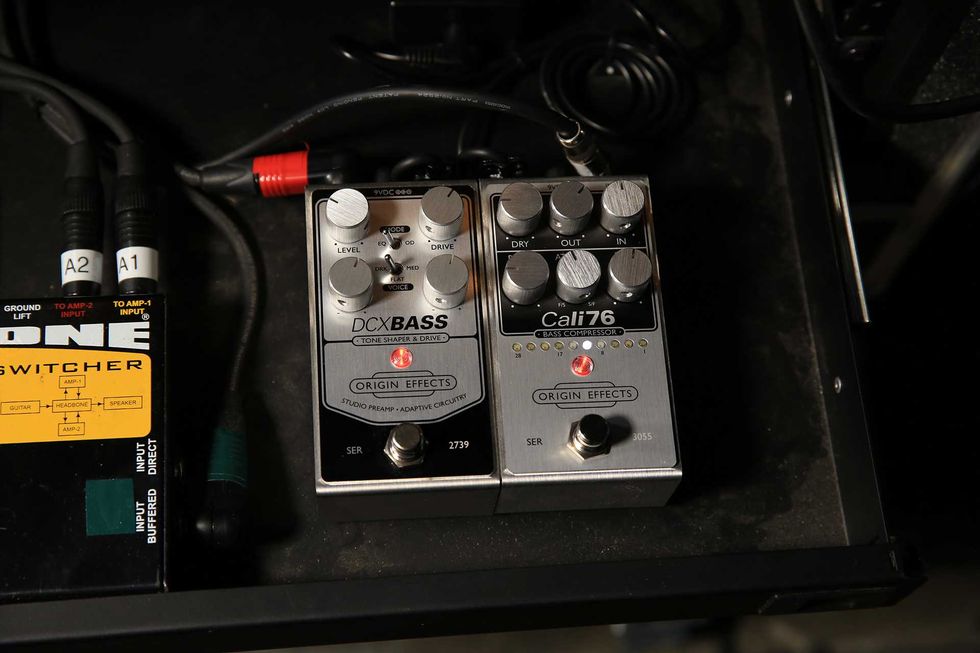
Way keeps things simple. Along with an Origin Effects DCX Bass and Cali76 set to push his Super Bassman, his setup includes a pair of Aguilar Agros, an MXR Sub Octave Bass Fuzz, and a Malekko B:assmaster.
